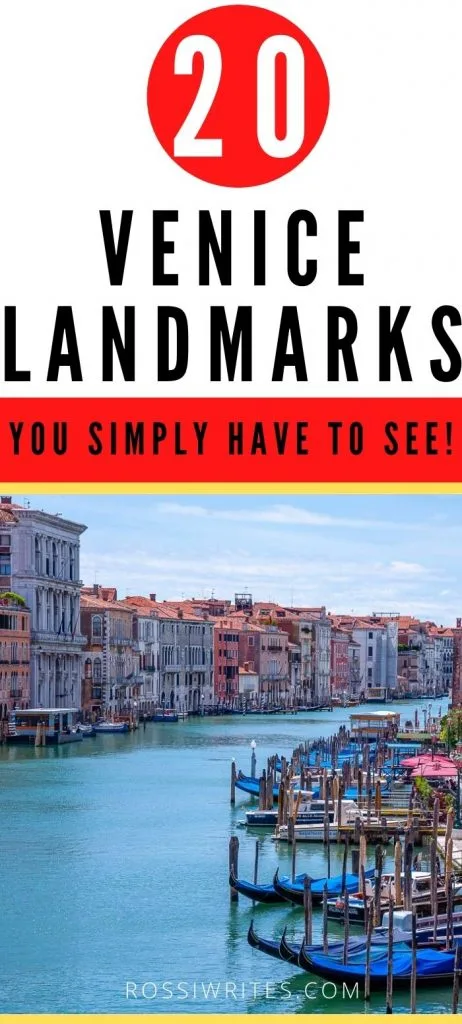Here are 20 landmarks in Venice, Italy that you simply have to see during your visit to the city of water.
Ticking each of these landmarks off your travel wish list will show you the very best of Venice and will help you delve into Venetian history, traditions, and art.
This way, you will discover Venice in the most authentic way.
For its unique location in the heart of the Venetian Lagoon, architectural beauty, and rich collection of art, Venice is one of the most famous places in the world. This is a city that is 1,600 years old.

Founded right after the Fall of the Roman Empire in the West, throughout the centuries, Venice rose to be a powerful player in the politics and art of the Middle Ages and the Renaissance. The Most Serene Republic of Venice ruled over the trade in the Mediterranean Sea, developed highly advanced for its day technologies, printed thousands of books, and influenced the arts and sciences in Europe and beyond.
And while the Republic ceased to exist in 1797, the legacy and heritage of Venice are such that to this day they inspire and attract people from all over the world to the fabled city of water.
There is much to be seen and enjoyed here. Especially, if you have an interest in history, architecture, art, beautiful views, and quirky sights. To maximise your sightseeing opportunities in Venice, then, a plan is a must.
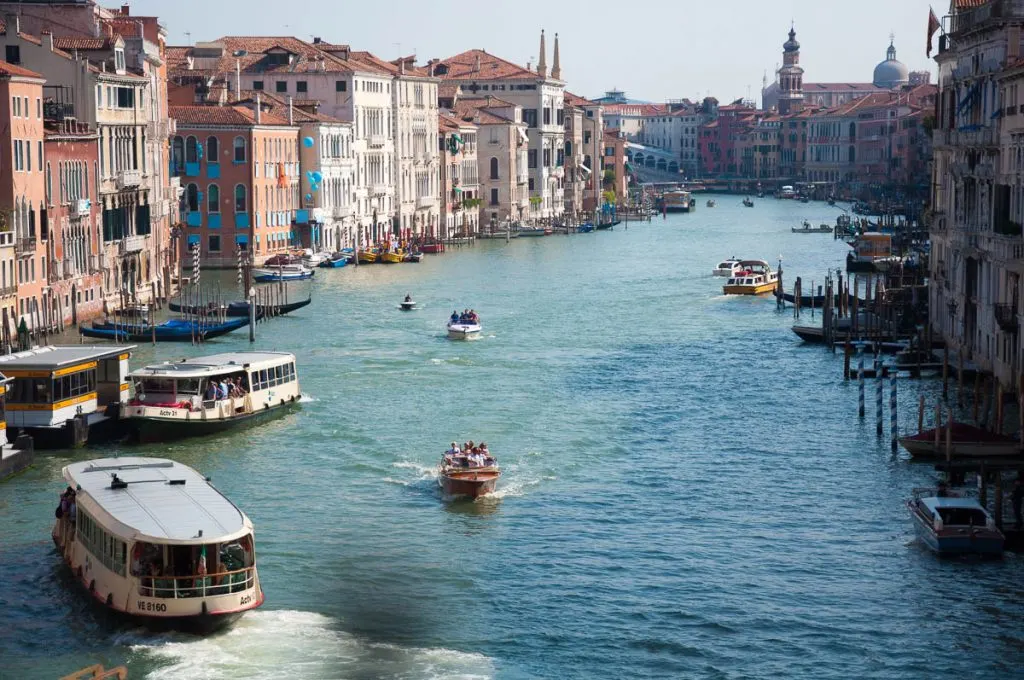
So, this blog post provides you with a handy list of the landmarks of Venice you simply cannot miss. Each one of them reveals in detail different facets of the Venetian history and traditions. As a whole, these 20 Venice landmarks are also the best representation of Venetian art and architecture. Visiting some or all of them will expand your understanding and appreciation of Venice and the events that shaped it.
I have listed these 20 must-see Venice landmarks in the relative order of their importance. At the end of this blog post, I have also included a map showing you their precise locations. This way, you can plan your visits in the most convenient for you way.
All the details and the tips shared in this blog post are based on my explorations of Venice over a period of 15 years (with six of them spent living next door to the city of water). I have distilled the best information in order to make your own visit to Venice a truly great experience.
In addition (and, especially, if this is your first trip to Venice), have a look at these two blog posts:
- 45 Essential Tips for Venice – for handy tips on how to navigate the city of water and book your acommodation; and
- 101 Hidden Gems in Venice – for 101 things to do and see here off the beaten track.
Now, let’s start!
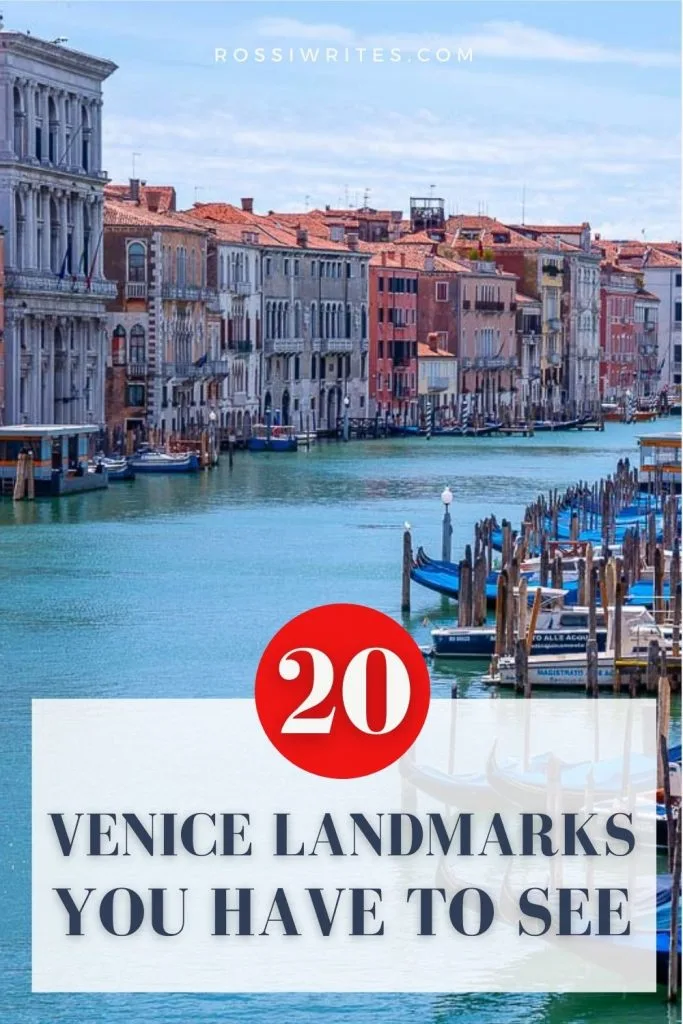
20 Venice Landmarks You Simply Have to See (With Map, Photos, and Curious Facts)
1. Grand Canal (Canale Grande) in Venice, Italy
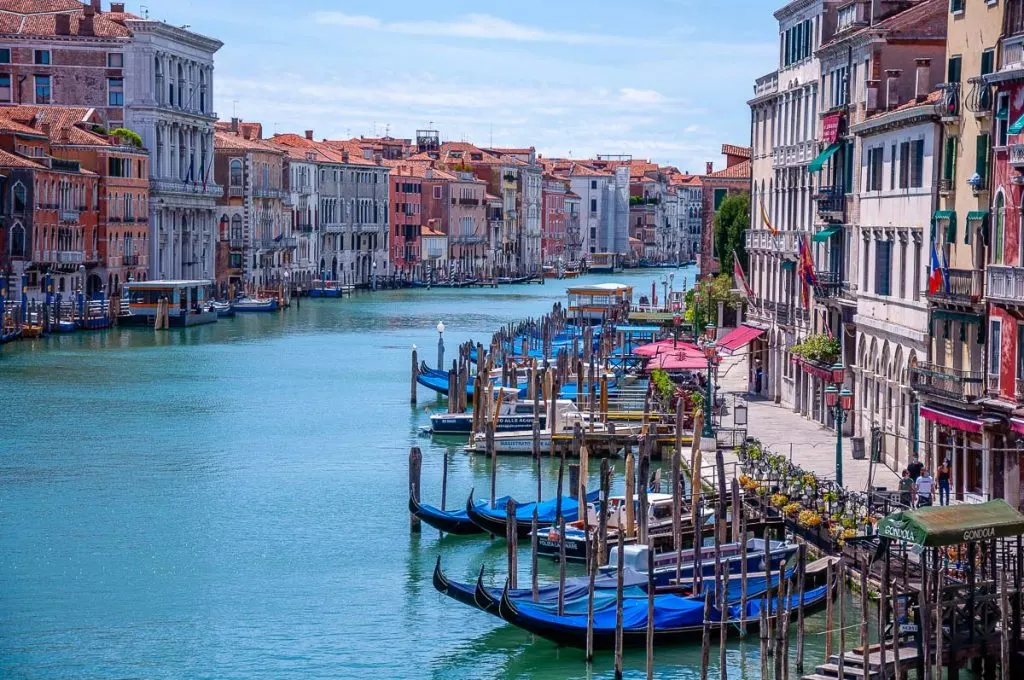
The Grand Canal in Venice is rightfully considered to be the world’s most beautiful thoroughfare. It curls in an upturned S-shape right across Venice just like a ribbon that is being tied around a precious present.
Canale Grande (as it is known in Italian) was initially the course of a river that flowed into the Venetian Lagoon. Throughout the centuries, it underwent many changes as the city of Venice grew on the islands along its shores. Nowadays, the canal is fed by the salty waters of the lagoon, it’s about 3,8 km long, between 30 and 70 m (some sources quote 90 m) wide, and on average, it’s 5 m deep.
Taking a boat down the Grand Canal – from its starting point at the Constitution Bridge (Ponte della Costituzione) down to its end next to the Punta della Dogana – is to see the very best of Venice. All the history and all the beauty in one place as the teal water splashes on the side of the boat and you clasp your camera up to your eye to take just one more photo which quickly becomes a dozen.
Venice’s major palaces and historic buildings line up the Grand Canal. From the Gothic Ca’ d’Oro to the early 20th-century Palazzo Salviati with its mosaic facade, there is lots to see and admire. The culmination is the Piazzetta San Marco with Venice’s most iconic buildings – the Doge’s Palace, the National Marciana Library, St. Mark’s Basilica and its impressive bell tower.
Curious Fact: Only four bridges span the Grand Canal. These are Constitution Bridge (Ponte della Costituzione), Bridge of the Barefoot Monks (Ponte degli Scalzi), Rialto Bridge, and Accademia Bridge. If you want to cross the Grand Canal at a different point, you can take a traghetto. This is a black boat that looks like a simple unadorned gondola. It has two oarsmen and for a small fee, it takes you across the Grand Canal at four points along its length.
Practical Tip: Take vaporetto line 1 from either Piazzale Roma or Venezia Santa Lucia train station and then travel all the way down the Grand Canal to Piazzetta San Marco. This way you can revel in the beauty of the Grand Canal and marvel at the most iconic buildings, palaces, and churches of Venice as they come into view.
Tickets and Tours: Click to buy your Venice vaporetto tickets in advance. If you prefer a private experience on the Grand Canal, then consider booking a daytime gondola ride followed by a romantic lunch or dinner. Alternatively, book this nighttime gondola ride.
More information: Check point 5 in this blog post for more information about Piazzetta San Marco.
2. St. Mark’s Square (Piazza San Marco and Piazzetta San Marco) in Venice, Italy
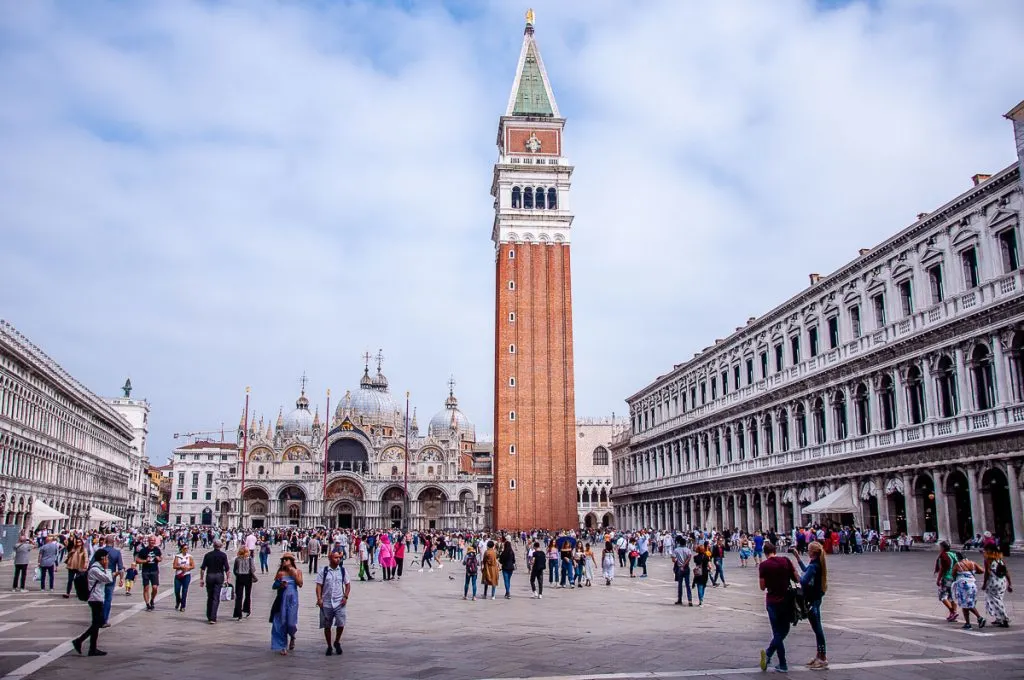
St. Mark’s Square is in many ways Venice’s most central point and one of its truly unmissable landmarks. It is a place that is monumental in size and yet so elegant that Napoleon declared it ‘the most beautiful drawing room in Europe’.
Majestic, symmetric, and large, Venice’s St. Mark’s Square attracts millions of visitors each year and yet it has dozens of secret corners. The imposing buildings of the Procuratie Vecchie and the Procuratie Nuove surround the square on three sides. In the past, this is where the Procurators of St. Mark worked and resided. After the Doge, they were the second-highest dignitaries in the Republic of Venice.
Nowadays, the buildings host the splendid Museo Correr, the small but very well curated National Archaeological Museum of Venice, and private companies. Behind the tall columns on the ground floor, you will find numerous small shops selling exquisite jewellery and Murano glass. Also here are two of Venice’s famous historic coffee houses – Caffe’ Florian and Gran Caffe’ Lavena.
Covered in marbles and elaborate mosaics, St. Mark’s Basilica glistens in the sun on the fourth side of St. Mark’s Square. It is at this point that an offshoot square, known as Piazzetta San Marco, stretches forward towards the teal waters of St. Mark’s Basin.
Together St. Mark’s Square and the Piazzetta San Marco form an upturned L. Along the L’s short stroke stand the Doge’s Palace on one side and the Marciana National Library on the other. Between them and almost on the edge of St. Mark’s Basin are Venice’s iconic pillars. One of them is topped by the winged lion of the Patron of Venice – St. Mark. On top of the other stands St. Theodore of Amasea – Venice’s first patron – known for slaying a demon-possessed crocodile in Egypt.
Curious Fact: Piazza in Italian means square in English. Curiously enough, St. Mark’s Square is the only actual piazza in Venice! All other squares in town – small and big ones – are known as campi. Campo means field in English. Up to a couple of centuries ago, this is exactly what the open spaces between the houses and palaces of Venice used to be – arable land where orchards grew, animals grazed, and even people were buried when they passed away. Nowadays, Venice’s former urban fields are paved. However, they are still called campi.
Practical Tip: St. Mark’s Square is where many of the main public events of the Venetian Carnival take place. The piazza gets incredibly busy then, so try to come as early as possible in order to bag a good spot.
Another tip is if you are feeling shattered after a long day of walking around Venice, don’t sit to relax on the historic steps of the Procuratie. Venetians consider it bad manners. You may be told off or even fined. Instead, head to the Giardini Reali – a small urban garden right behind the Procuratie and the National Marciana Library where you can rest on one of the benches surrounded by lush vegetation.
Tickets and Tours: A visit to the Museo Correr, the National Archaeological Museum of Venice, and the Monumental Rooms of the National Marciana Library is much recommended. You can buy a ticket for all three which also gives you fast track access to the Doge’s Palace.
More information:
- Italian Piazzas – 20 Most Beautiful Squares in the Veneto
- Carnival of Venice – History and Traditions of the World’s Most Illustrious Party
3. St. Mark’s Basilica (Basilica di San Marco) in Venice, Italy
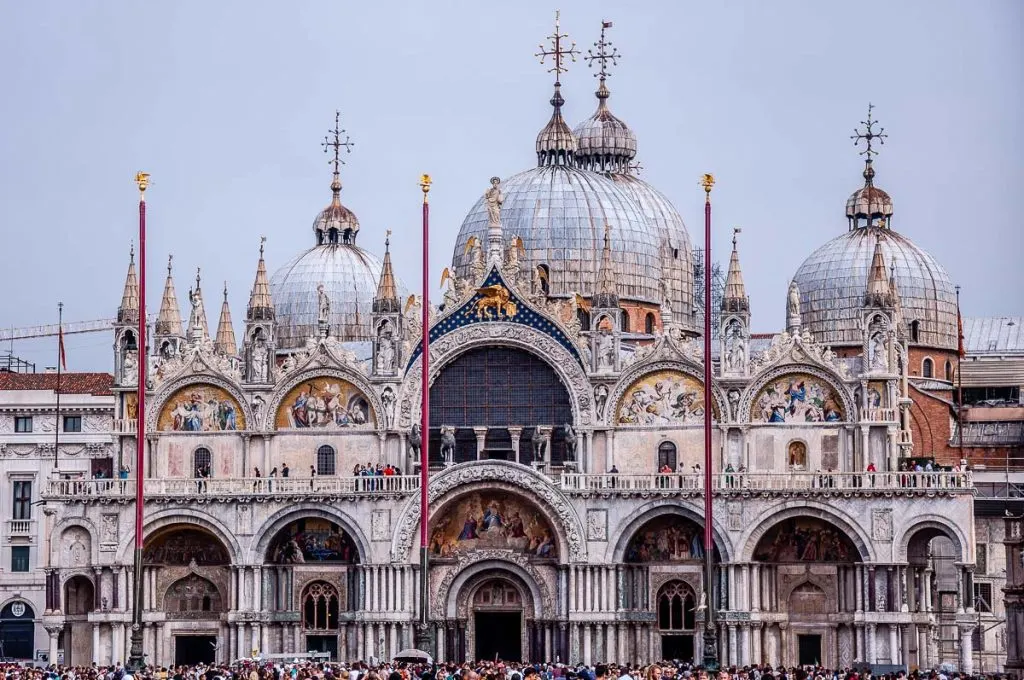
St. Mark’s Basilica in Venice is one of the most splendid churches in Europe and the world. Lavishly decorated with precious marbles and complex scenes in mosaics, this is one of the most resplendent jewels in Venice’s architectural and historic crown. It is a permanent source of pride for Venetians.
A famous landmark in Venice, the basilica is dedicated to St. Mark – the much-revered Patron of the city of water. His body was transferred from Alexandria in Egypt to Venice in the 9th century in a daring act of theft by two Venetian merchants. Built in the Byzantine style in the 11th century, the basilica is a much larger reincarnation of the churches that were originally erected to house the saint’s body.
To this day, St. Mark’s Basilica keeps the saint’s relics. It also preserves many other treasures. Inside the church, you can lose track of time in admiration of its domes and walls covered with dizzyingly gold mosaics. The Pala d’Oro – the retable of the high altar of the basilica – amazes with its meticulous craftsmanship and decoration of 1,927 gems.
The Triumphal Quadriga (also known as the Horses of St. Mark) is particularly famous. These are the four bronze horses dating back to the Classical Antiquity which were brought to Venice in 1204 after the Sack of Constantinople. Nowadays, their copies adorn the basilica’s facade. The originals are kept inside. Also inside the basilica, don’t miss the St. Mark’s Museum. From illuminated manuscripts to silk tapestries, a visit to it will delight anyone with an interest in history and Christian artefacts.
Curious Fact: St. Mark’s Basilica is one of the very few buildings in Venice with a crypt. The crypt is fashioned of the remains of the earliest churches dedicated to St. Mark that had once stood at this spot. In the 11th century, the relics of the Patron Saint of Venice were laid to rest here. It was only in the 19th century that the relics were moved to the basilica’s high altar. The crypt of St. Mark’s Basilica is usually closed to the general public. One of the few ways to see it for yourself, is to join a guided tour after-hours.
Practical Tip: St. Mark’s Basilica is one of the major attractions in Venice. Thousands of tourists flock to see it each day. During the high season, the queue stretches long. There is a small charge to visit the basilica in addition to fees to see St. Mark’s Museum and the Pala d’Oro, and to access the outside terrace, the so-called Loggia dei Cavalli. It’s worth it! The precious artefacts deserve a closer look and the views of Venice from the loggia are spell-binding. Click here to check the most up-to-date prices on the Basilica’s official website.
Tickets and Tours: If you are on a tight schedule, click to buy a skip-the-line guided tour of St. Mark’s Basilica. Alternatively, pay a bit more and enjoy a guided tour with a skip-the-line entrance for both the St. Mark’s Basilica and the Doge’s Palace in Venice.
4. St. Mark’s Bell Tower (Campanile di San Marco) in Venice, Italy
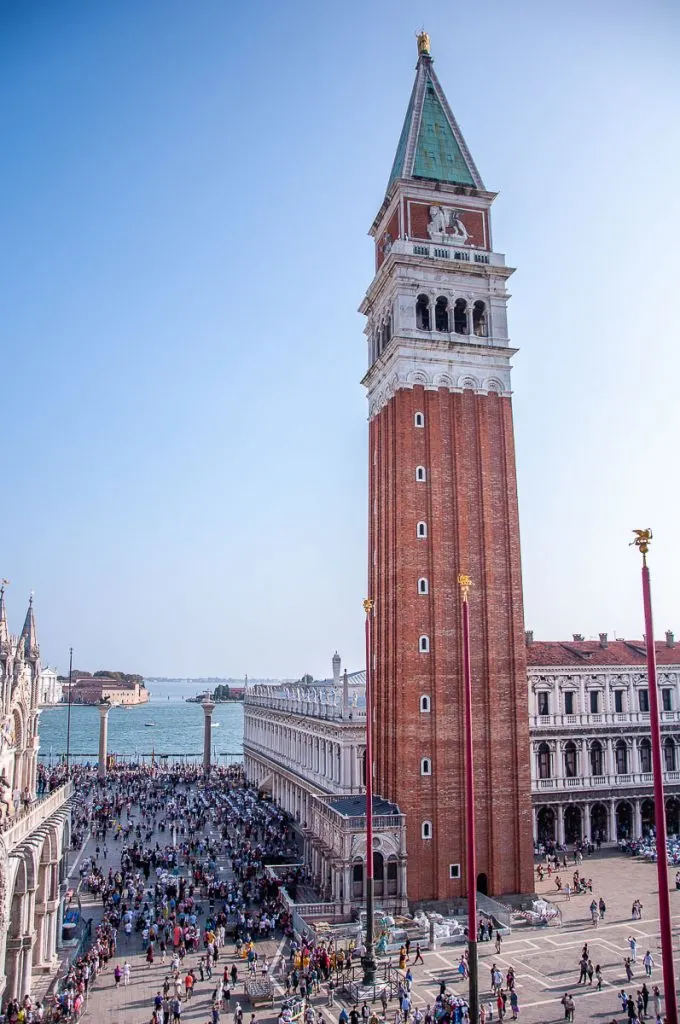
St. Mark’s Bell Tower is Venice’s tallest building and one of its most iconic structures. Almost 99 m high, this is a square brick tower with a pyramidal spire. It stands on the corner of St. Mark’s Square and Piazzetta San Marco and across from St. Mark’s Basilica and the Doge’s Palace.
From its belfry, you can enjoy some of the most inspiring panoramas of the Venetian Lagoon. A lift will whisk you up there swiftly from the ground level. The spectacle of Venice from above is something that forever stays in your mind.
A tall tower has been standing at this same spot for at least a millennium. It was built, they say, on Roman foundations and it was initially, used as a watchtower and a lighthouse. In the 12th century, it was topped with a belfry. The current design of the St. Mark’s Bell Tower dates back to the beginning of the 16th century. However, the tower you see here nowadays was erected between 1903 and 1912 after the original one collapsed in 1902.
Topped by the golden figure of Archangel Gabriel, St. Mark’s Bell Tower protrudes over Venice. It’s one of the first things you see as you approach the city of water from a distance. At the base of the tower stands the Loggetta. This is a rectangular building that is lavishly decorated with bronzes and marbles. It was designed by Jacopo Sansovino who was also the architect of the adjacent National Marciana Library in Venice.
In all its long life and shapes, St. Mark’s Bell Tower has been an intrinsic part of Venice. Its bells announced the hours of work, rest, and prayer during the centuries when watches were still a thing of the future. In 1609, the famous astronomer Galileo Galilei demonstrated the first astronomical telescope from the bell tower’s belfry. Nowadays, St. Mark’s Bell Tower plays a central role during the Venetian Carnival for it’s from its head-spinning height that the Flight of the Angel and the Flight of the Eagle are performed. This is when a person is suspended with steel ropes above St. Mark’s Square and it’s then slowly lowered down to the ground!
Curious Fact: The bell towers in the Venetian Lagoon are traditionally fashioned after St. Mark’s Bell Tower. Copies of it also exist in many different places around the world. Two notorious examples are the small town of Piran in Slovenia and the Venetian Resort in Las Vegas, USA.
Practical Tip: St. Mark’s Bell Tower is one of the most visited places in Venice. During the high season, you can expect long queues. To avoid having to stand in line, you can head there early in the morning or towards the end of its opening hours. Keep in mind that the bell tower may be closed in the case of adverse weather conditions.
Tickets and Tours: You can buy a ticket in situ to visit St. Mark’s Bell Tower in Venice. During the high season, consider buying a ticket in advance to avoid queuing. Tickets are usually sold directly through the official site only during the high season, so keep an eye on it for the most up to date details.
5. Doge’s Palace (Palazzo Ducale) in Venice, Italy
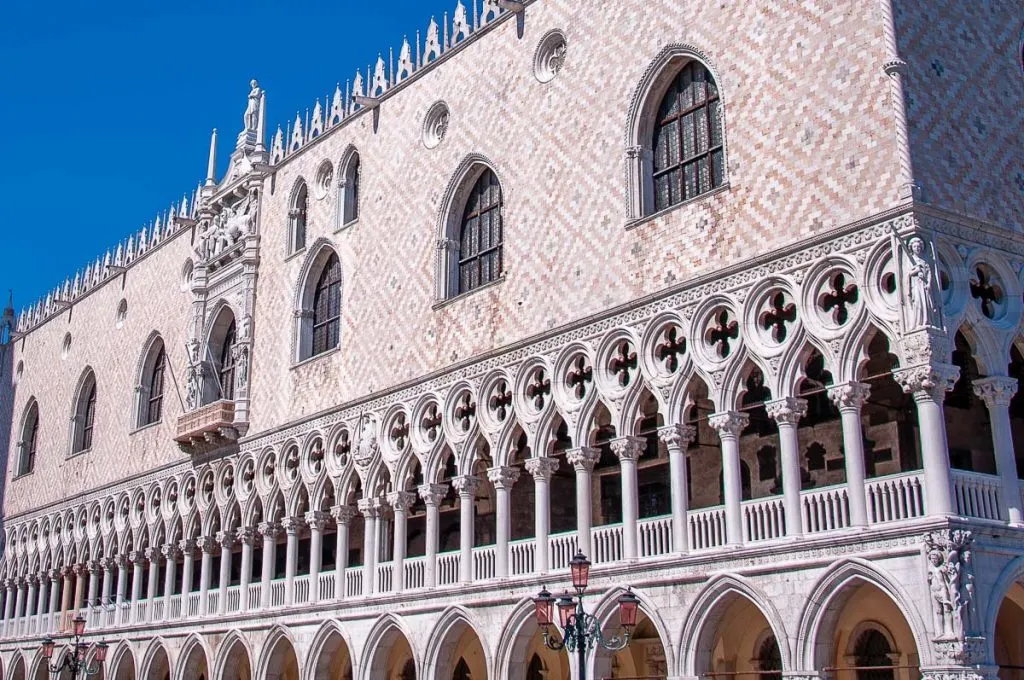
The Doge’s Palace in Venice commands the eye with its solid yet elegant proportions. Built of carefully interlaced white Istrian stone and red Verona marble, the centuries have weathered its facade to a beautiful salmon pink colour which is especially intense early in the morning.
The portico on the ground floor and the loggia right above it, make this otherwise sturdy building seem to almost float in the air. One of the pinnacles of the Venetian Gothic style, for centuries the Doge’s Palace was the beating heart of the Most Serene Republic of Venice. The cogs and wheels of the Republic’s complex political apparatus turned within the palace’s walls and the Doge also lived here.
The Doge (from Latin dux) was the leader of the Republic. He was elected for life but his title was not hereditary. From the end of the 7th century to the end of the 18th century, this was the highest position one could hold in Venice. The political powers of the Doge stretched not only over the Republic but also over its extensive commercial and military interests.
The Doge’s Palace has been standing at the same spot since the beginning of the 9th century. Originally, it took the shape of a fortified castle and it was built on land owned by the then Doge – Agnello Participazio. Since then, the Doge’s Palace has been rebuilt, extended, and remodelled several times. The construction of its current building started around 1340 with several portions of it being added gradually throughout the following centuries.
Nowadays, the Doge’s Palace is one of the most important places in Venice. It has an unparalleled catalogue of art, an extensive collection of historic arms, and many rooms and halls decorated by some of the most famous artists of the Venetian School like Tintoretto and Titian. To fully immerse yourself in the history and art of Venice, a visit to the Doge’s Palace is a must.
Curious Fact: Throughout its existence, the Doge’s Palace in Venice has been ravished by fires several times. Many works of art perished in the flames, among them masterpieces by Carpaccio and Bellini. The fire on 20th December 1577 was particularly destructive. The reconstruction effort afterwards led to the creation of the enormous canvas Il Paradiso painted by Tintoretto and his workshop. 22 m long and 7 m high, this is one of the largest oil paintings in the world. You can admire it in all its glory in the Chamber of the Great Council – one of the biggest rooms in Europe.
Practical Tip: You need plenty of time to fully experience the art, history, and architecture of the Doge’s Palace in Venice. It is not a sight that can be rushed. The building is large, spacious and a visit includes lots of walking, some stair-climbing, and long moments of looking up at lavishly decorated ceilings. Wear your most comfortable shoes and before your visit, have something to eat and drink, and also pop to the loo.
Tickets and Tours: Click to buy your fast track ticket for the Doge’s Palace in Venice in advance. If you are on a tight schedule, then consider joining a guided tour with a skip-the-line entrance. Alternatively, pay a bit more and enjoy a guided tour with a skip-the-line entrance for both the Doge’s Palace and the St. Mark’s Basilica in Venice.
6. Bridge of Sighs (Ponte dei Sospiri) in Venice, Italy
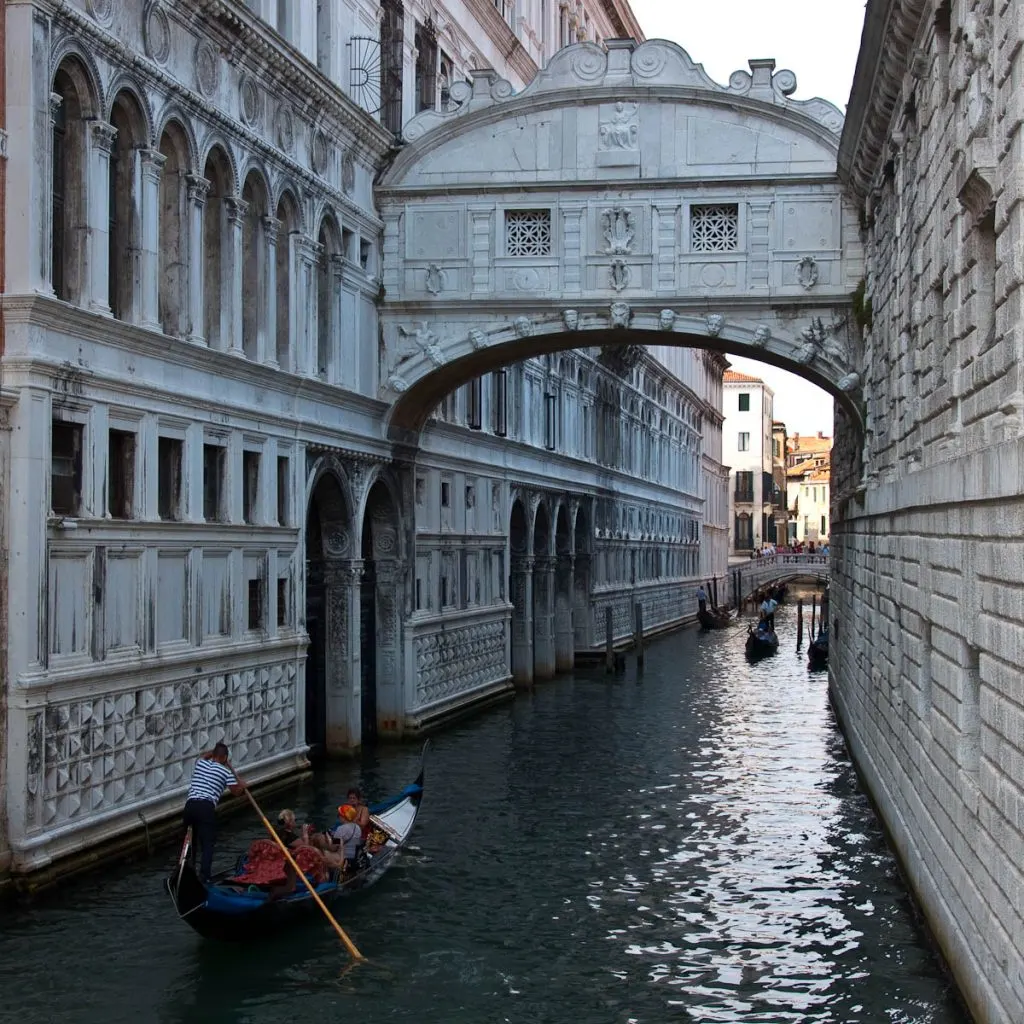
Venice’s Bridge of Sighs is famous all over the world and it’s often thought of as a romantic location. Built in the 17th century, it was designed by Antonio Contin. He was the nephew of the architect of Venice’s other very famous bridge – Ponte di Rialto.
Made of white Istrian stone and completely enclosed, the bridge is beautifully decorated and elegantly arched on the outside. Inside, it’s rather dark and it feels cold, for the two small windows are covered with a floral stone lattice that forbids almost all light from entering.
You will find the Bridge of Sighs just a few steps away from St. Mark’s Square. It stands over the canal known as Rio del Palazzo and it connects the interrogation rooms in the Doge’s Palace to the New Prisons. In the past, those condemned to custodial sentences in Venice had to cross it on the way to their cell. Through the small windows of the bridge, they could glimpse one last view of the city of water – that of the sparkling St. Mark’s Basin dotted with boats and the island of San Giorgio Maggiore in the distance. The legend says that the prisoners would utter a heavy sigh and this gave the bridge its name.
Nowadays, however, many prefer to embrace the different romantic notions that have proliferated in recent decades about the Bridge of Sighs. Hence, you can often spot couples kissing while trying to take a selfie of themselves with the bridge in the background.
Curious Fact: The Bridge of Sighs is another Venice landmark that has inspired several copies in shape or in name worldwide. The most famous ones are in the British University towns of Oxford and Cambridge. There is also a Bridge of Sighs in Lima, the capital of Peru.
Practical Tip: Ponte della Paglia – a bridge right next to the Doge’s Palace – offers a perfect viewpoint for the Bridge of Sighs. It is one of the most crowded spots in Venice, too. Head there early in the morning or late in the evening for people-free photos. Alternatively, see the Bridge of Sighs from one of the other bridges built over Rio del Palazzo.
Tickets and Tours: You don’t need a ticket to see the Bridge of Sighs from the outside. If you want to cross it, then you will need to visit the Doge’s Palace in Venice. Click to buy your fast track ticket in advance. If you are on a tight schedule, then consider joining a guided tour with a skip-the-line entrance. Alternatively, pay a bit more and enjoy a guided tour with a skip-the-line entrance for both the Doge’s Palace and the St. Mark’s Basilica in Venice.
7. Rialto Bridge (Ponte di Rialto) in Venice, Italy
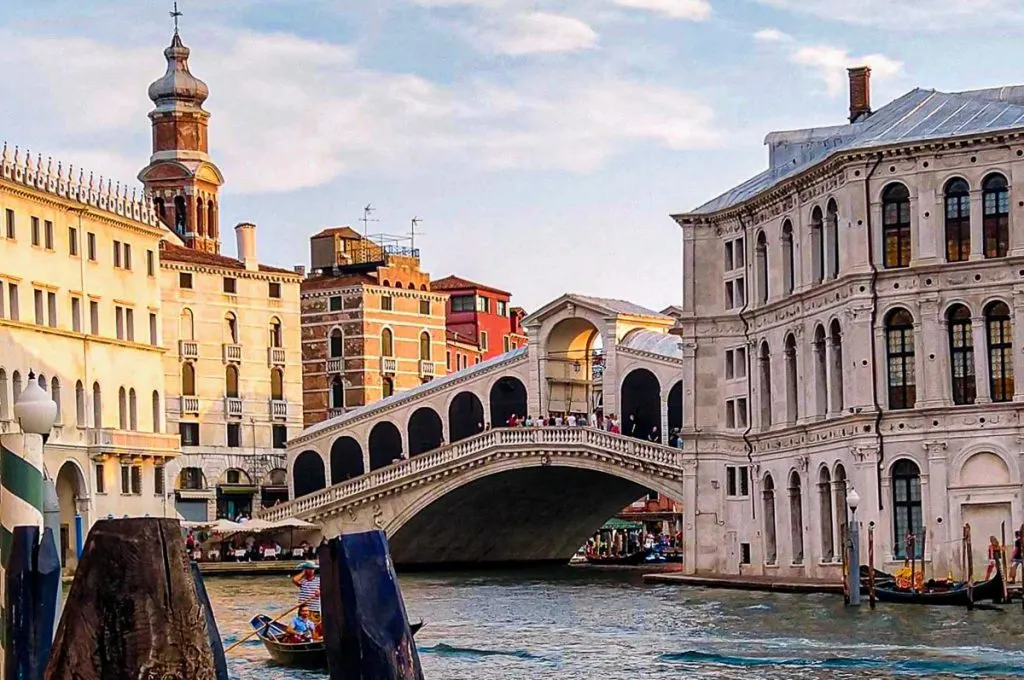
Known all over the world, the Rialto Bridge is one of the most iconic Venice landmarks. It’s 48 m long and it straddles the Grand Canal at its narrowest point. It’s also the oldest of the four bridges that cross Venice’s main thoroughfare.
The information about when exactly the first bridge was built at this place is conflicting. Some historic chronicles point to the end of the 12th century. Whereas others quote the exact year of 1264. In any case, it looks like the Rialto Bridge started life as a simple pontoon structure where wooden planks were placed on top of wooden boats to make it possible to cross over. It is thought that this first basic bridge was replaced by a wooden bridge on stilts in the 13th century.
The name of this first bridge (or bridges) was Ponte della Moneta (Bridge of the Coin). There were two theories about it. One was that the reference to a coin was a throwback to the times when people had to pay an oarsman to get them across the Grand Canal by boat. According to the other, the bridge got its name as Venice’s old Mint (Zecca) was near its eastern end.
Throughout the centuries, the wooden bridge assumed the name Ponte di Rialto from the nearby Rialto Market. The market was a place of utmost importance to Venice as this is where shiploads of precious goods would arrive from all over the Mediterranean Sea and further beyond. During its existence, the bridge was damaged several times. It even collapsed in 1444. Eventually, it consisted of two ramps supported by tall poles. The ramps met in the middle and could be open to let ships pass underneath. In the 15th century, two rows of shops were added to the structure.
The current stone bridge was erected between 1588 and 1591. In the previous decades, illustrious architects such as Andrea Palladio and even the great sculptor and artist Michelangelo had submitted designs for a new iconic bridge for Venice. The commission was eventually given to the architect Antonio del Ponte.
Nowadays, the Rialto Bridge is a favourite spot for a photo of the Grand Canal in Venice. Tourists flock to it in their droves and jostle for the best angle for a selfie. Small shops selling jewellery, crafts, and souvenirs populate the bridge’s arcades. It is a really beautiful place within close proximity to the ten-centuries-old Rialto Fish Market. It affords some of the best views of the Grand Canal and the majestic buildings that surround it.
The Rialto Bridge really is the spot where you can both feel the verve of Venice and dispair at the issues created by overtourism. During the day, the bridge is often taken over by tourists who linger, take photos, and crowd the space. In the early morning and late in the evening, the Rialto Bridge is a dream to visit. It stands tall, proud, and elegant and it offers one of the best introductions to the true beauty of Venice.
Curious Fact: Stones from the ruins of the Roman theatre in the nearby city of Padua were used for the construction of the Rialto Bridge in Venice. You can read more about it under point 5 in this blog post.
There are stone bas-reliefs on both sides of the Rialto Bridge. On one side you can see St. Mark and St. Theodore of Amasea – the Patron Saints of Venice. On the other, there is a depiction of the Annunciation with Archangel Gabriel and the Virgin Mary.
Practical Tip: For a stunning bird’s-eye view of the Rialto Bridge, head to the rooftop terrace of the nearby luxury department store Fondaco dei Tedeschi. Visits are free of charge. It’s strongly advised to book in advance on the official website, as the number of visitors and the length of stay on the terrace are restricted.
More Information: Have a look at points 1, 2, an 3 in this blog post for more information about the architect Andrea Palladio.
8. Gallerie dell’Accademia in Venice, Italy
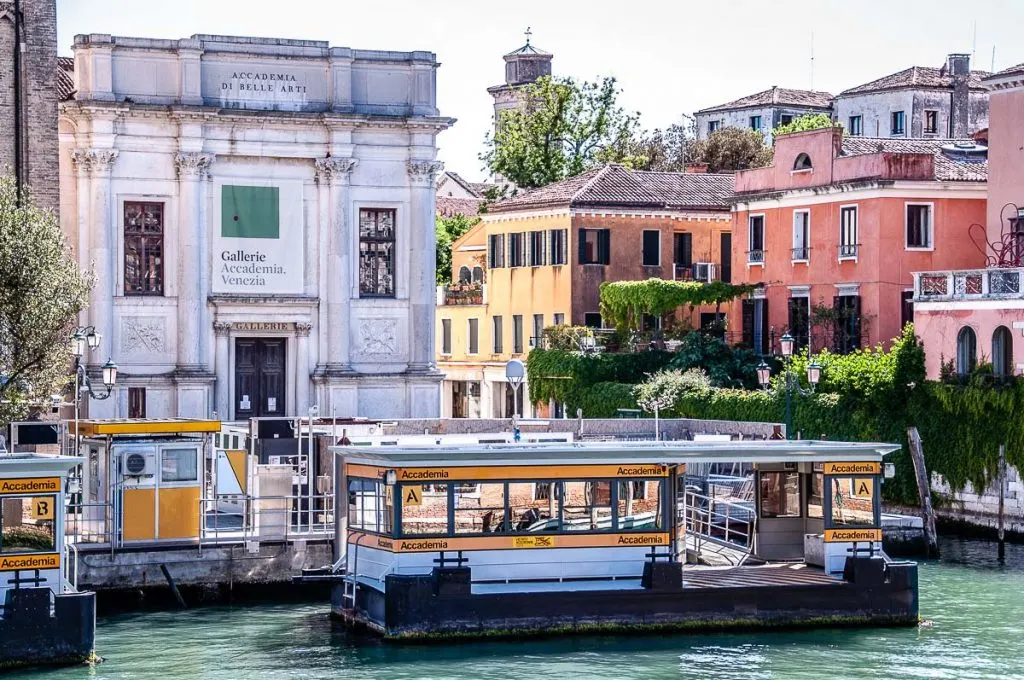
The Gallerie dell’Accademia is a large art gallery showcasing the best of Venetian art between the 14th and the 18th centuries. You will find it in the Sestiere of Dorsoduro, right on the edge of the Grand Canal. The elegant Accademia Bridge stands in front of it.
The Gallerie dell’Accademia are, perhaps, most widely known as the place where the world’s most famous drawing – Leonardo da Vinci’s Vitruvian Man – is kept. To the disappointment of many, the Vitruvian Man is not on permanent display. Due to its fragile nature, the Gallerie show it to the general public only on special occasions. The last time was in 2019 as part of an exhibition of Leonardo’s drawings held for the 500th anniversary of the great artist’s death.
The Vitruvian Man aside, the Gallerie dell’Accademia are still very much worth a visit. Especially, if you have an interest in the Venetian School. Here you can admire famous paintings by the likes of Giorgione, Andrea Mantegna, Paolo Veronese, Giovanni Bellini, Vittore Carpaccio, Titian, and Tintoretto. Walking through the spacious rooms and halls, you feel like you are in a book on the history of art. Paintings that we usually see on the pages of books, here stand in front of you in all their splendour. At times, it can be a bit overwhelming!
The 14th-century buildings in which the collections of the Gallerie dell’Accademia are housed have an interesting story. They were formerly the church, the monastery, and school (Scuola Grande) of Santa Maria della Carita’. The Scuole Grandi in Venice were confraternities – charitable and religious organisations for the laymen of the city of water. Created in 1260, the Scuola della Carita’ was the oldest among them. It was disbanded after the Fall of the Republic of Venice at the end of the 18th century.
The Gallerie dell’Accademia themselves started their life in 1750. At the time, it was an Academy of Fine Arts (Accademia di Belli Arti di Venezia) where painting, sculpture, and even art restoration were taught. Works of art were bought to be restored and to be used in the teaching process. After Napoleon and Habsburg Austria dissolved the Republic of Venice, dozens of public buildings, monasteries, and convents were closed in the Republic’s former territories. Many of the works of art that had once adorned them were dispersed and ended up in private collections and large museums abroad. What was salvaged, was collected by the academy.
In 1807, the academy moved to the former premises of the Scuola della Carita’. In 1817, it showed the nucleus of its collection to the general public for the first time. Towards the end of the 19th century, the teaching academy and its galleries became independent from one another. Hence, Venice’s Gallerie dell’Accademia were born in earnest.
Curious Fact: From Byzantine-inspired paintings to Baroque masterpieces, the 37 halls of the Gallerie dell’Accademia trace the evolution of Venetian art. Here, you can expect to see the largest collection of Venetian art in the world dating from the 14th to the 18th centuries. The gallery has a very well-curated online presence. You can see and explore many of its works of art from the comfort of your home.
Practical Tip: Visiting the Gallerie dell’Accademia in Venice can be an overwhelming experience. Especially, if Venetian art is (mostly) new to you in terms of themes and developments. In this case, my advice is to have an extensive look at the official website of the gallery prior to your visit. Check the different halls and earmark works of art that you want to learn a bit more about and then see in person. This way you will have points of reference to build your visit around. Otherwise, simply walking from hall to hall in the galleries, it all can quickly become a bit of a colourful blur.
Alternatively, you can centre your visit around a specific period, a particular artist or a certain topic. For example, you can aim to see the Renaissance paintings in the collection, everything by the Bellini brothers or all paintings that feature Venice.
The best option though is to hire a private tour guide, a real Venetian to take you around the Gallerie dell’Accademia and introduce you to the treasures in its collection. Luisella Romeo from SeeVenice has a tour tailored around this must-see Venice landmark. Erika Cornali from WhenInVenice also has tours covering many different churches and museums in Venice with the Gallerie dell’Accademia taking a pride of place among them.
Tickets and Tours: You can buy your ticket from the official website in advance or from the ticket office at the Gallerie dell’Accademia on the day of your visit. Keep in mind that ticket prices may vary depending on temporary exhibitions and events.
9. Accademia Bridge (Ponte dell’Accademia) in Venice, Italy
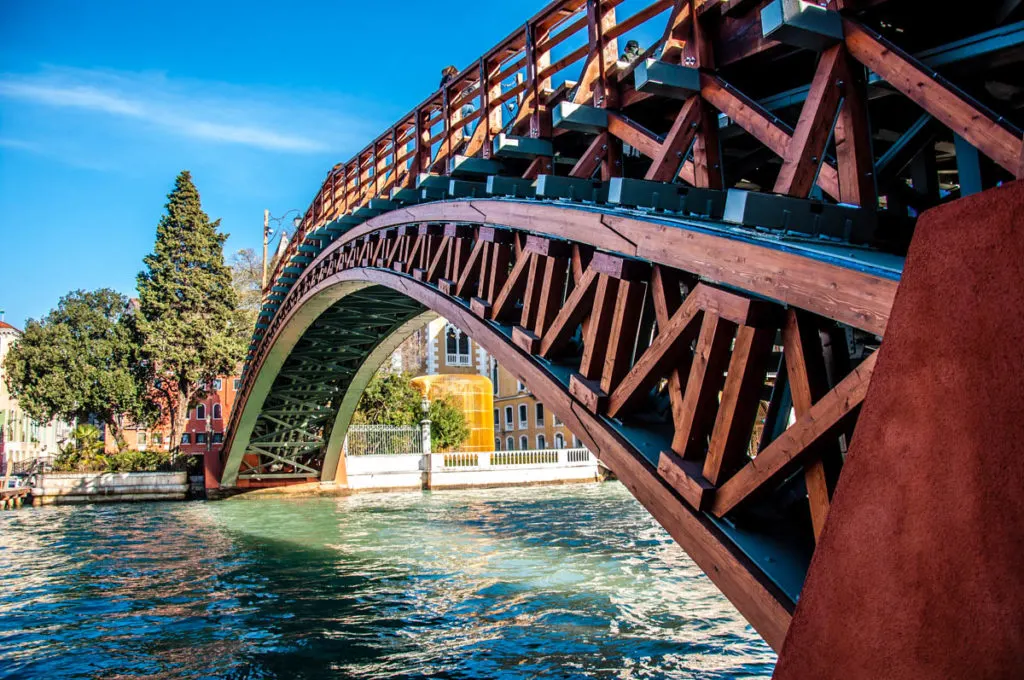
The Accademia Bridge is one of the only four bridges that span Venice’s Grand Canal. For me, this is also the bridge that affords the most iconic view of the city of water – that of the southern end of the Grand Canal with the Basilica della Salute dominating the background. It is a perfect marriage of water, architecture, and sky. I can literally spend hours lost in contemplation here. Which wouldn’t be a great thing to do as, actually, one is not supposed to linger on Venice’s bridges and thus obstruct the foot traffic.
The Accademia Bridge stands right in front of the Gallerie dell’Accademia. It connects the Venetian sestieri of Dorsoduro and San Marco. It was built over 37 days in 1933 under the guidance of eng. Eugenio Miozzi.
In fact, suggestions to build a bridge over the Grand Canal at this particular spot had been circulating in Venice since the 15th century. In the first half of the 19th century, an architect even proposed to excavate an underwater tunnel so as to not obstruct the passage of boats nor disturb the harmonious views.
Between 1852 and 1854, the British engineer Alfred Neville built the first bridge here. It was called Ponte della Carita’. The Venetians embraced the convenience of crossing on foot the Grand Canal at this spot even though it was a toll bridge. However, the design of the flat iron bridge displeased them. They found it too industrial and unbecoming to the historic architecture of their city. Plus, at high tide, it obstructed the boat traffic. Even worse, by the 1930s the bridge was corroded.
A national competition for a stone bridge was announced and a winning design was chosen. In the meantime, the old metal bridge had become unsafe. So, as a short-term measure, it was decided to erect a temporary wooden bridge, then dismantle the old metal bridge, and wait for the right time to erect the new stone bridge. The right time never came and the wooden Accademia Bridge is still standing.
Curious Fact: When it was built, Venice’s Accademia Bridge was the largest wooden arch bridge in Europe. Since then, however, its wooden parts have had to be replaced several times at a great cost. In the 1980s, all wooden elements of the bridge were replaced and metal arches were inserted to support it. In 2018, the bridge underwent another large-scale restoration. It cost 1,7 million euros, took seven months, and was sponsored by the Luxottica Group.
Practical Tip: They say that there is only one place in Venice from which you can see both the Rialto Bridge and the Accademia Bridge on the Grand Canal. This is the Mario Baratto Hall of Ca’ Foscari – the Gothic palace that houses the University of Venice. Click to read more about it and to find out how to visit it yourself.
10. Basilica di Santa Maria della Salute in Venice, Italy
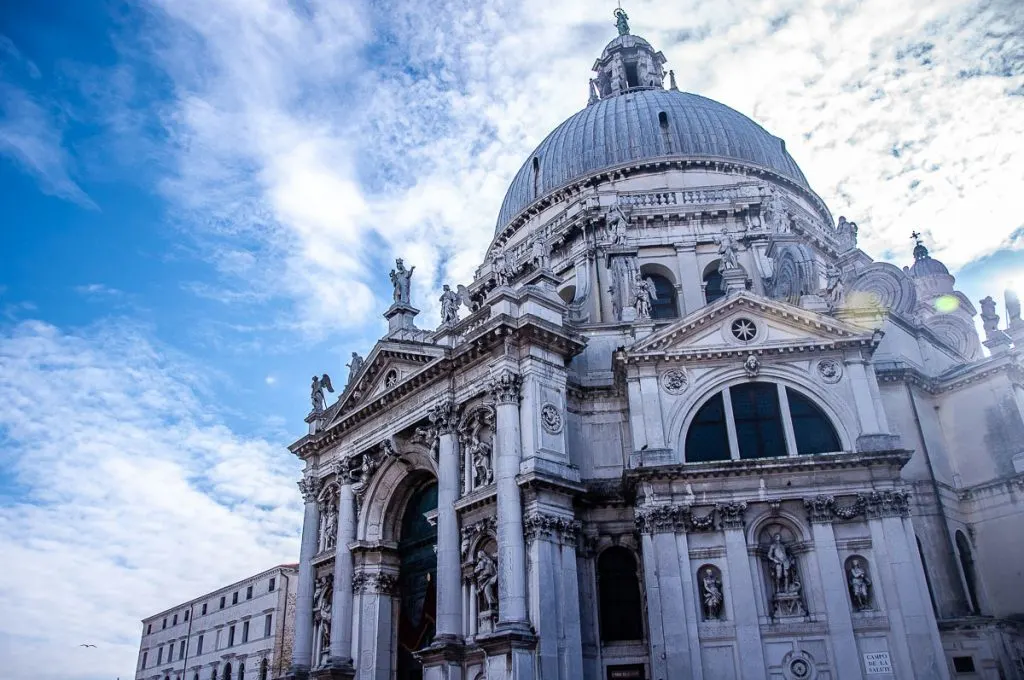
Commonly known as the Basilica della Salute, this is one of the most famous buildings in Venice. It stands on the southern end of the Grand Canal and dates back to the 17th century. Its construction lasted over 50 years and it was erected after a devastating bout of the plague slaughtered nearly one-third of all Venetians between 1630 and 1631.
The basilica was built as a votive offering to the Virgin Mary – protector of the Republic of Venice. It was hoped that she would deliver the city of water from the plague. Hence the name of the basilica in English translates as St. Mary of Health. The Basilica della Salute was designed by the architect Baldassare Longhena. 26 years old at the time, he won the competition that had been announced for the construction of the new votive church. There were eleven submissions and Longhena’s vision of a round, crown-shaped sacred building led to the creation of one of the most beautiful Baroque churches in Europe.
History is never a thing of the past in Venice. Centuries-old traditions and customs are celebrated here all throughout the year. As such, 21st November is still one of the city’s largest and most heartfelt festivals. This is when Venice thanks the Virgin Mary for saving it from the 1630/1631 pestilence. On this day, Venetians flock to the Basilica della Salute. A special votive bridge is built on pontoons over the Grand Canal. People cross it and wait patiently to light a candle and pray in the basilica. A large festive market is set up for the occasion nearby.
The Basilica della Salute features in many iconic images of Venice. You can enjoy a beautiful panorama of it standing on the Accademia Bridge. A visit is a must for its history, architectural beauty, facade ornate with sculptures, and many works of art. Right next to the basilica, you can also explore the Pinacoteca Manfrediniana which houses the Diocesan Museum of Sacred Art.
Curious Fact: The Basilica della Salute in Venice is particularly famous for its organ concerts. Keep an eye on the official website (in Italian) for any announcements about future organ music events. It’s one of the most soul-inspiring experiences you can have in the city of water.
Practical Tip: If you are at St. Mark’s Square and you want to visit the Basilica della Salute, you don’t have to walk all the way to the Accademia Bridge to cross the Grand Canal. Instead, consider taking a traghetto. This is a black unadorned gondola with two oarsmen who – for a small charge – will take you across the water. For the Basilica della Salute, head to the Santa Maria del Giglio traghetto stop.
11. Basilica di Santa Maria Gloriosa dei Frari in Venice, Italy
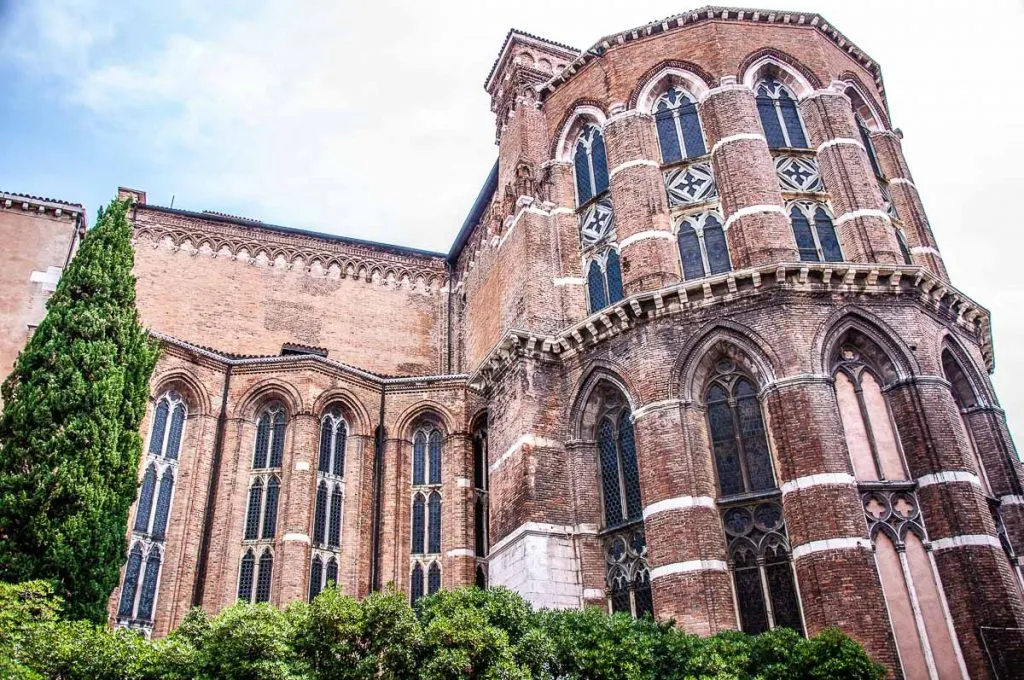
Commonly known as the Basilica dei Frari (or simply Frari), this is an imposing church built of red bricks in the heart of the Venetian sestiere of San Polo. Its facade is strikingly bare. Inside the basilica, however, you will find an impressive collection of art and the grandiose tombs of many famous Venetians.
A church had stood at this place since the 13th century. The current building was erected between the 14th and 15th centuries. It belongs to the Order of Friars Minor. Their founder – St. Francis – had spent time in the Venetian Lagoon in 1220 after a journey to the Orient.
Come to the Basilica dei Frari to see some of the most well-known works of art produced by the Venetian School. A special mention deserve two imposing paintings by Titian you can admire here: the sublime ‘Assumption of the Virgin Mary’ on the high altar and the skillfully dynamic in terms of use of space and movement ‘Pesaro Madonna’.
A personal favourite of mine that you can see here is Giovanni Bellini’s ‘Madonna and Child with Ss. Nicholas of Bari, Peter, Mark, and Benedict’ (also known as the ‘Frari Triptych’ or ‘Pesaro Triptych’). This is one of the pinnacles of the Early Venetian Renaissance. Stand in front of the triptych to admire fully the three-dimensional effect that the painting produces.
The basilica’s wooden choir stalls are astonishing in their detail. They are adorned with complex scenes in intarsia – a technique used to create images with different species of wood in various shades. The monumental tombs of the famous artist Titian, the neoclassical sculptor Antonio Canova (only his heart is buried here), and several Venetian doges are astounding in their size and ornamentation.
All in all, the Basilica dei Frari is truly one of Venice’s major points of interest. A visit to it is also a great excuse to explore in-depth the sestiere of San Polo where many more important Venetian buildings await to be discovered by the curious traveller.
Curious Fact: Wonderful concerts are regularly held in the Basilica dei Frari in Venice. Especially popular is the Christmas choir concert. Keep an eye on the concert calendar on the official website of the basilica for updates about any future performances. Listening to music in the basilica’s beautiful surroundings is a memorable experience.
Practical Tip: Make sure that you are dressed appropriately to visit the Basilica dei Frari in Venice. As a place of worship, a certain dress code is expected. To best plan your visit, make sure that you consult the basilica’s official website in advance. It has a lot of information about the different works of art you can see there. You can also download a map of the basilica, check its opening hours, and learn more about its history.
Tickets and Tours: The small admission fee for the Basilica dei Frari in Venice is currently set at three euros. It’s more than worth it!
12. Ca’ d’Oro Galleria Giorgio Franchetti in Venice, Italy
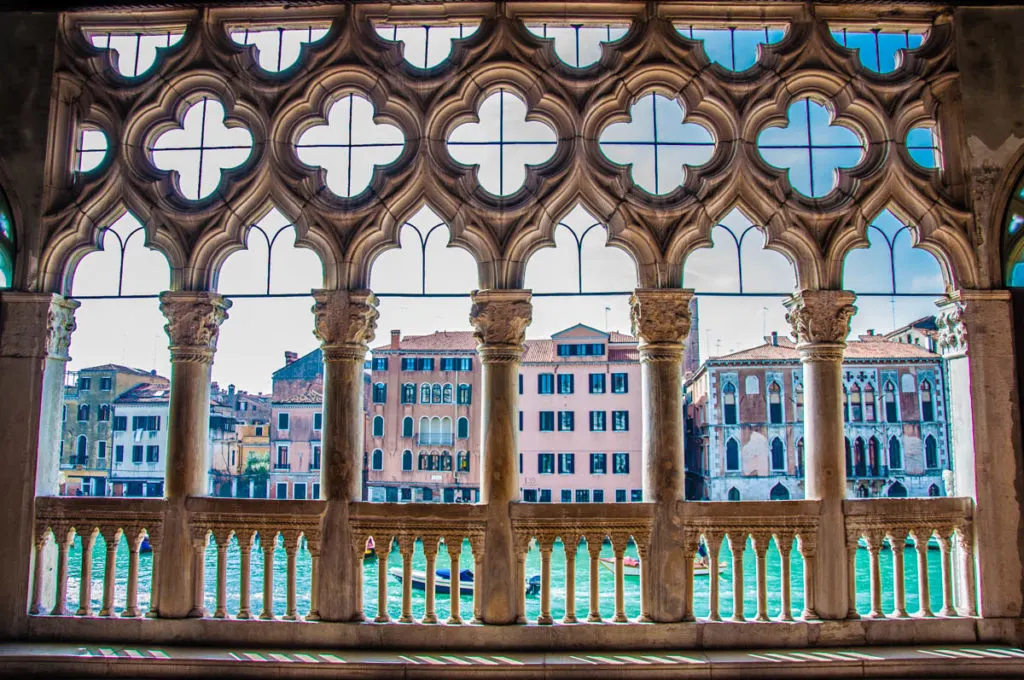
Ca’ d’Oro – the Golden House – is the most striking Late Gothic Palace in Venice. Facing the Grand Canal, it grabs the eye and charms the imagination with the intricate stone openwork of its balconies. You need to visit this Venetian landmark for two reasons. One is the architecture of Ca’ d’Oro itself. The other is the priceless collection of art exhibited inside it.
Ca’ d’Oro was built between 1428 and 1430. Its architects were the father and son Giovanni and Bartolomeo Bon. They are particularly well-known as the creators of the incredibly ornate Porta della Carta of another major Venice landmark – the Doge’s Palace.
Originally, the facade of Ca’ d’Oro was lavishly adorned with gold leaf and painted in intense colours. It also sported patterns made of colourful stones. Hence, before long everyone had forgotten the palace’s actual name (Palazzo Santa Sofia) and started referring to it as the House of Gold. Since then, the gold and the colours have faded by the moniker has stuck.
Nowadays, Ca’ d’Oro functions as an art gallery. Inside it, you can see the collection amassed by Baron Giorgio Franchetti – the palace’s last private owner. Originals by Andrea Mantegna, Vittore Carpaccio, Titian, and Francesco Guardi as well as by the Flemish artists Jan Van Eyck and Anthony Van Dyck can be admired here. The gallery also has the now faded and cracked frescoes that were once painted by Titian for another of Venice’s most important buildings – Fondaco dei Tedeschi.
For me, the most impressive thing to see in Ca’ d’Oro, however, is the flooring of the portego – the large covered space on the ground floor which connects the waterside portal with the landside entrance of the palace. The floor here is made of ancient marbles ordered in complex patterns. Its creation was a work of love for Giorgio Franchetti and it’s a truly wonderful thing to see in Venice! Unfortunately, the constant threat of acqua alta makes its preservation a very difficult task.
Curious Fact: The famous ballerina Marie Taglioni once lived in Ca’ d’Oro. Born to an Italian father and a Swedish mother, the ballet La Sylphide was choreographed especially for her. Unfortunately, Taglioni approached Ca’ d’Oro in Venice with a rather heavy touch. She made several significant changes to the Gothic palace which in later years were reverted as much as possible by Baron Franchetti.
Practical Tip: Enjoy the beautiful views of the Grand Canal from the balconies of Ca’ d’Oro. In order to admire its facade to its best effect, make sure that you see this jewel of the Venetian Gothic architecture from the water either on board a vaporetto, gondola or water taxi.
Tickets and Tours: Check Ca’ D’Oro’s official website for the most up-to-date information about ticket prices and opening hours. You can buy a ticket just for Ca’ d’Oro or a combined ticket for Ca’ d’Oro and another top attraction in Venice – Palazzo Grimani – directly from the official website.
13. Jewish Ghetto (Ghetto Ebraico) in Venice, Italy
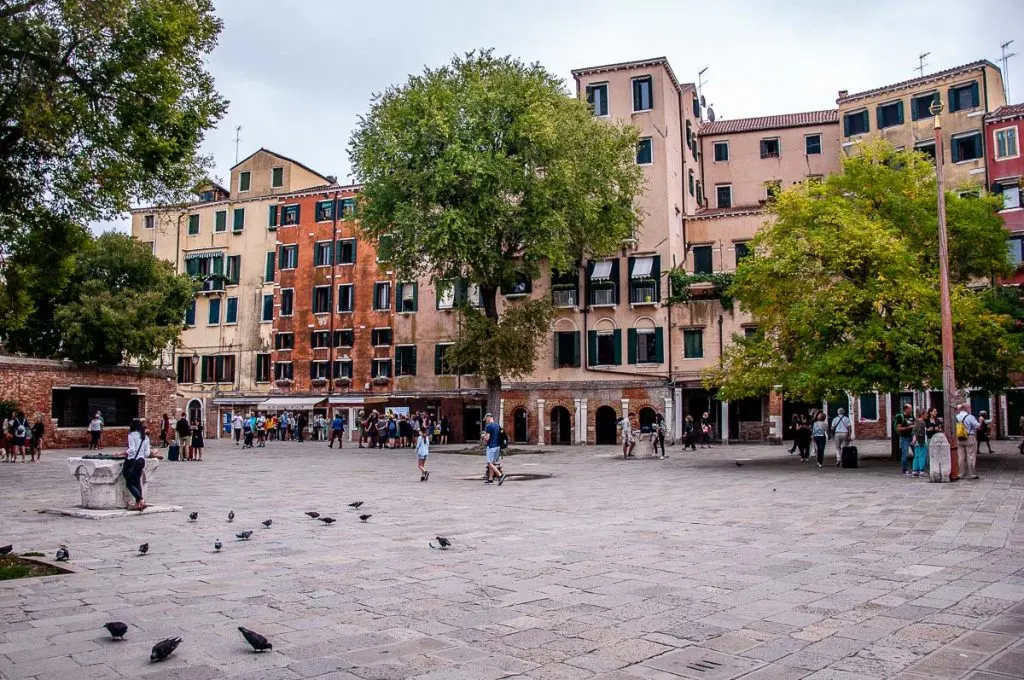
The world’s first ghetto was created in Venice on 29th March 1519. On this date, the Doge Leonardo Loredan and the Venetian Senate signed a decree stipulating that all Jewish inhabitants of the city of water had to reside in a small, gated area of roughly seven acres. Its location was in the Venetian sestiere of Cannaregio, where the city’s foundries had been casting cannons for centuries. The area was known as the geti (or getti) from the Venetian word geto – a foundry and/or casting. With time, the soft g became hard and guttural. The term ghetto was coined.
There had been a Jewish presence in Venice since at least the 11th (some sources indicate the 12th) century. While Jews could trade in the city, in general, they were not allowed to reside permanently here. With the growth of the Jewish population and the financial benefits of their presence, the Doge and the Venetian Senate assigned them their own quarter in Venice, promised religious freedom, and offered protection. However, there were lots of stipulations and conditions attached.
Only two bridges led in and out of the ghetto. Its gates were shut each night and heavily guarded until the next day. Jews could only engage in pre-approved by the Republic occupations like the managing of the local pawnshops. They also had to wear a yellow hat as a sign of identification.
With the Fall of the Republic of Venice in 1797, Napoleon’s troops burned down the gates of the Jewish Ghetto. Its inhabitants received the same status as the other citizens of Venice. Almost a century and a half later, with the advent of the Second World War and with Italy under a fascist government, 246 Jews were deported from Venice to the death camps. Only eight of them returned.
Nowadays, the Jewish Ghetto is one of Venice’s must-see landmarks. It is a place of tall buildings that had many floors added on top centuries ago when the numbers of the people living here rapidly expanded but they were not allowed to live anywhere else in Venice. There are five synagogues, a very well-curated Jewish Museum, many great shops, and the very popular Gam Gam restaurant serving excellent kosher food.
Curious Fact: The Jewish Ghetto in Venice has three parts: Ghetto Vecchio (Old Ghetto), Ghetto Nuovo (New Ghetto), and Ghetto Nuovissimo (Newest Ghetto). The Ghetto Nuovo however is older than the Ghetto Vecchio. This is because the words new and old here refer to the foundries that had originally been at these places rather than the Jewish quarters created here later in history. The Ghetto Nuovissimo was added in 1633 next to the other two and it is the smallest of the three. The historic Jewish Cemetery, on the other hand, is on the island of Lido in the Venetian Lagoon.
For more about Venice’s Jewish Ghetto and its history, have a look at the official website of a seminal exhibition which was held in Venice in 2016: Venice, The Jews and Europe 1516-2016.
Practical Tip: Venice’s Jewish Ghetto is a short distance away from Piazzale Roma and the Venezia Santa Lucia train station. You can get here quickly on foot as soon as you arrive in the city of water.
Tickets and Tours: Click to buy your ticket for the Jewish Museum in Venice. The Jewish Museum of Venice organises guided tours to the Levantine Synagogue and the Luzzatto Midrash. If you want to learn more about the history, the architecture, and the hidden corners of the Venetian Ghetto, consider joining a guided tour. There are many different options, so have a look at this, this, and this one for ideas and prices.
14. Scuola Grande di San Rocco in Venice, Italy
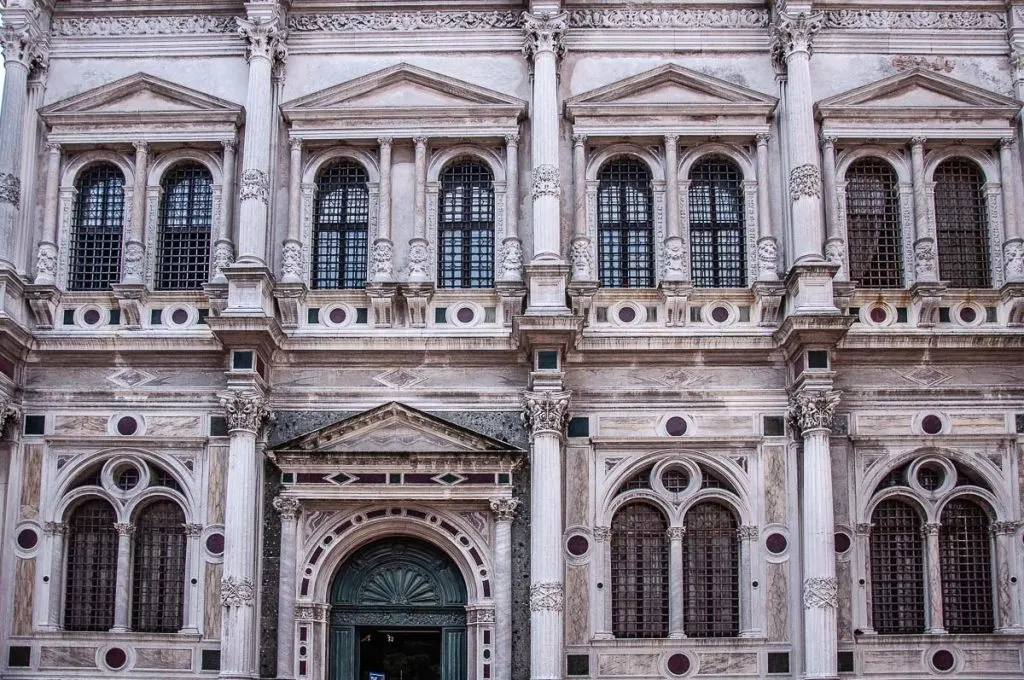
The Scuola Grande di San Rocco is one of Venice’s most lavishly decorated and most famous buildings. For its history, architecture, and wonderful collection of art including monumental masterpieces by Tintoretto, it is a must-see landmark in the city of water.
The construction of the building began in 1515 and was completed in 1560. Throughout this time, three different architects worked on it with the first one being Bartolomeo Bon. The building was erected to house the Confraternity of St. Roch. This was one of the charitable and religious communities (locally called scuole) for the laymen of the city of water. Their Scuole Grandi and Scuole Piccole are dotted around Venice and preserve some of the most exciting collections of Venetian art and crafts.
You will find the Scuola Grande di San Rocco next to the Church of San Rocco in the Venetian sestiere of San Polo. With its protruding columns, its facade looks heavily inspired by the triumphal Roman arches. Its grandiosity is only rivalled by Tintoretto’s cycle of paintings inside. Inspired and with bold use of contrast between shadow and light, you will want to take a moment to absorb how enormous they are. Especially, on the ceiling in the Upper Hall (Sala Superiore)! Here, I was also particularly taken with the late 17th-century allegorical wooden sculptures by Francesco Pianta.
The Treasure of the Scuola Grande di San Rocco is another must-see here. From the elaborate reliquaries holding the fingers of St. Roch and St. Andrew to a Mamluk carpet, there are many things to make you catch your breath. Don’t miss the original painting by Giorgione depicting Christ Carrying the Cross. Curiously enough, his work is topped by a semi-circular painting by Titian (and assistants). As Titian was Giorgione’s student, it is interesting to compare the pictorial style and the strengths of both in such close proximity.
Curious Fact: Venice had, in total, seven Scuole Grandi (Great Schools) and several Scuole Piccole (Minor Schools). The first to be founded was the Scuola Grande della Carita’ in 1260. The Scuola Grande dei Carmini was the last to be founded in 1767.
Practical Tip: Make sure that you also visit the Church of San Rocco next door. San Rocco (or St. Roch as he is known in English) is a Catholic Saint protector against the plague. His body was transferred to Venice in 1485 and since 1520 his urn has been housed within the church’s monumental high altar. The church is also where you can see large canvases by Tintoretto and remaining fragments of a fresco cycle by Pordenone.
Tickets and Tours: You can buy your tickets for the Scuola Grande di San Rocco and for the Church of San Rocco in-situ on the day of the visit. Have a look at the official website for prices and opening times.
15. Peggy Guggenheim Collection in Venice, Italy
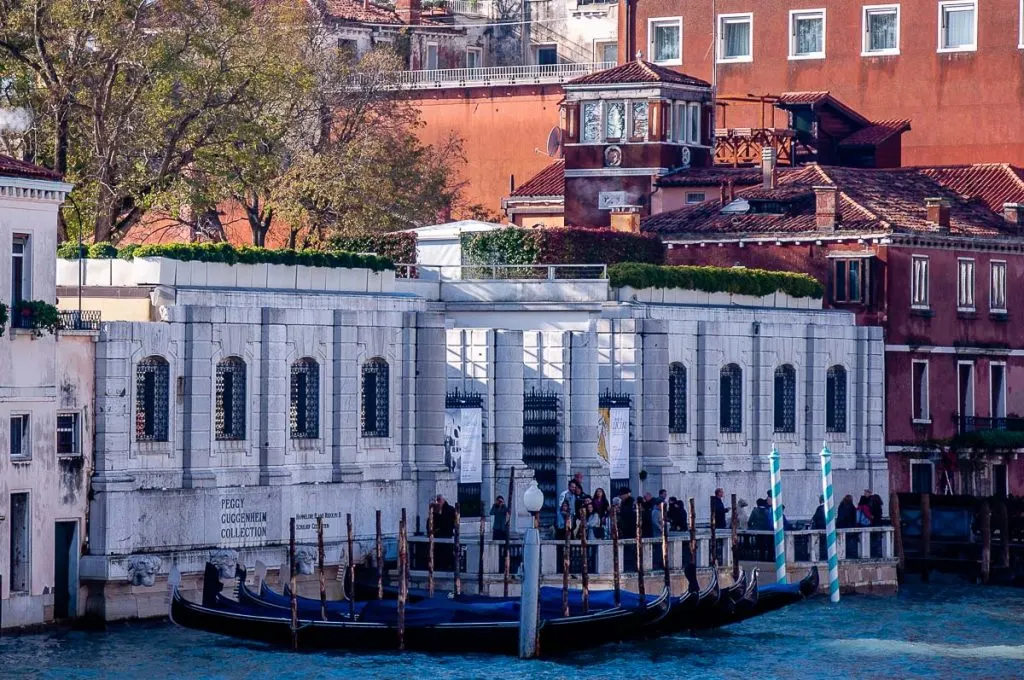
The Peggy Guggenheim Collection is a must-see in Venice. Especially, if you have an interest in modern art and/or if you want to find out what it must have been to live in Venice in the 1950s and 1960s with a private gondola and the most coveted black book of art contacts in the world. Alternatively, come here if you have spent a few days in Venice and you are starting to feel a bit overwhelmed by all the Venetian Gothic, Renaissance, and Baroque art. The abstract world of the European and American art of the 20th century offers a rather stark contrast to it.
The larger-than-life figure of Peggy Guggenheim – a mecenate and a woman who knew how to elevate life to an art form – permeates the many rooms of this art gallery housed in the 18th-century Palazzo Venier dei Leoni on the Dorsoduro shore of the Grand Canal. Her ashes are interred next to her beloved dogs in a corner of the palazzo’s garden.
The Peggy Guggenheim Collection exhibits many masterpieces of modern art, has a sculpture garden, organises acclaimed events, and even holds a free art workshop for children every Sunday. Even if modern art is not your cup of tea, it is a wonderful and whimsical place to visit in Venice. Not least for the great views of the Grand Canal and The Angel of the City sculpture revelling in ecstasy at the best viewpoint.
Curious Fact: There are many curious facts both about the personality of Peggy Guggenheim and her homonymous collection. I will leave you with this quote from the grand lady of modern art herself: “It is always assumed that Venice is the ideal place for a honeymoon. This is a grave error. To live in Venice or even to visit it means that you fall in love with the city itself. There is nothing left over in your heart for anyone else. After your first visit, you are destined to return at every possible chance or with every
possible excuse.”
Practical Tip: Combine a visit to the Peggy Guggenheim Collection with an in-depth exploration of the Venetian sestiere of Dorsoduro. Many sights and tourist attractions here clamour for your interest. From the Gallerie dell’Accademia, the Basilica della Salute, and Punta della Dogana to Palazzo Cini, Scuola Grande dei Carmini, and even the gondola-making and -repairing boatyard Squero Tramontin, there is lots to do and see here.
Tickets and Tours: Click to buy fast track tickets for the Peggy Guggenheim Collection in Venice. For added convenience, you can get a combined ticket for the Peggy Guggenheim Collection and the Doge’s Palace in Venice, too.
16. Punta della Dogana in Venice, Italy
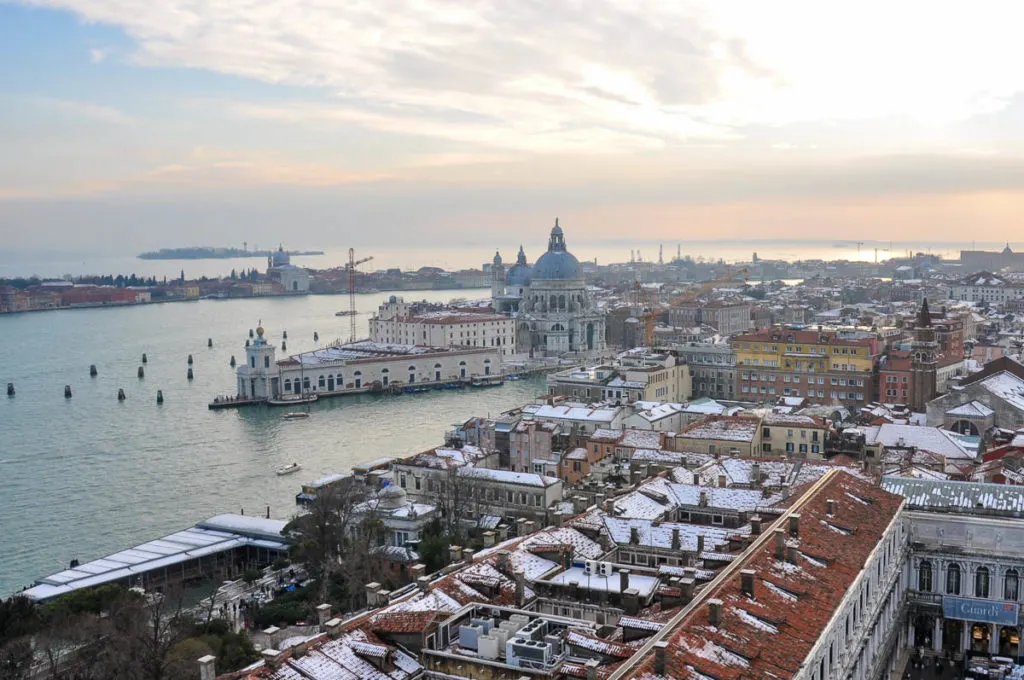
Punta della Dogana is that triangular piece of land in Venice at the tip of which the Grand Canal meets the Giudecca Canal and together they flow into the blue expanse of the Basin of St. Mark. Thus, Punta della Dogana affords trilateral views of Venice – the Doge’s Palace diagonally to the left, the island of San Giorgio Maggiore straight ahead, and the island of Giudecca with the Palladian Redentore Church to the right.
Yet that’s not all! For Punta della Dogana is also where several of Venice’s most important buildings stand – from the Basilica della Salute to Venice’s former Sea Customs House (Dogana da Mar). The latter was built in the second half of the 17th century to control the merchant ships that brought a constant flow of goods to Venice from all around the Mediterranean Sea and further beyond. Nowadays and after extensive restoration work, the building functions as an art museum under the name Punta della Dogana.
Both the triangular tip and the former customs house – which is also triangular in shape – often feature in some of Venice’s most iconic paintings and photos. Special attention here deserves the sculptural group on top of the triangular building. It features two Atlases holding a gilded bronze sphere representing the Earth on their backs. The figure of Fortune stands on top of the globe. It turns according to the direction of the wind to show how fickle the whims of fortune are.
All in all, Punta della Dogana is a great area to go for a walk and to stop for a few minutes lost in contemplation of the Basin of St. Mark and several major Venice landmarks. Right at the end of the triangular tip, there is a lamppost. At times, a sculpture is positioned here, too thus adding even more interest to the place.
Curious Fact: An old Venetian legend tells of a large mythical serpent. It lives in the waters just off the tip of the triangular Punta della Dogana. Something like a distant cousin of Nessie from Scotland’s Loch Ness. Several fishermen have sworn to have seen this serpent appear out of the dark waters on moonless nights. Click to read more about Venice’s legends and mysteries and to discover more allegedly haunted corners of the city of water.
17. Arsenale, Naval Historical Museum, and Ships Pavillion (Arsenale, Museo Storico Navale, and Padiglione delle Navi) in Venice, Italy
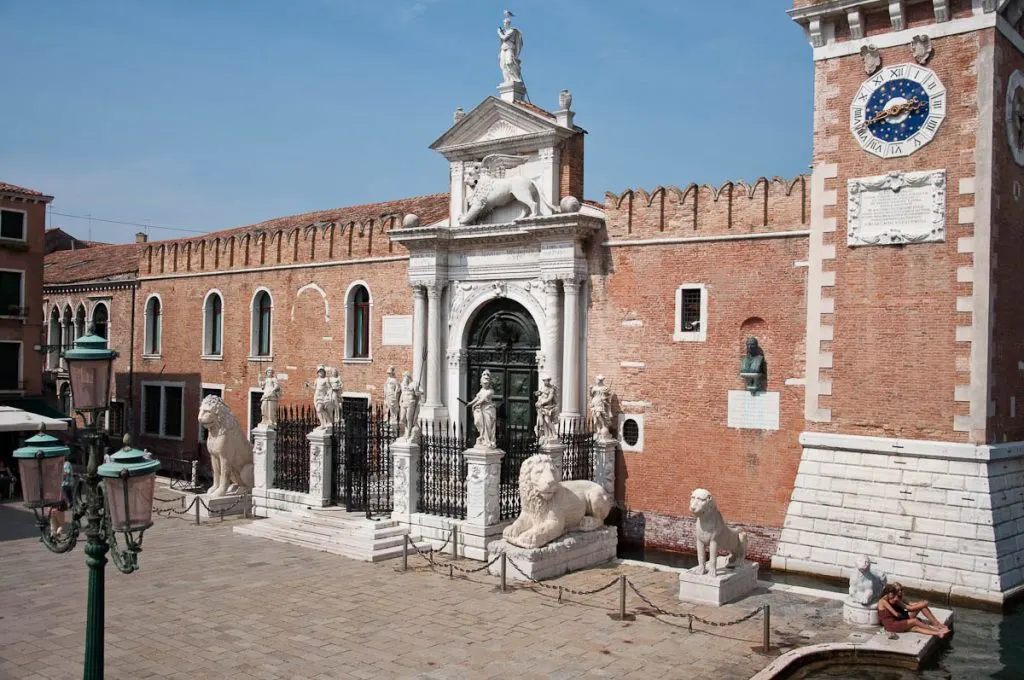
The Arsenale, the Naval Historical Museum, and the Ships Pavillion are intrinsically connected in terms of the naval history of the Republic of Venice. They are also very close to one another, hence I combined them under the same entry in this list of the major Venice landmarks.
For centuries, the Republic of Venice was a leading player in the trade and the military manoeuvres in the Mediterranean Sea and further beyond. Its fleet was large, powerful, and far-reaching. Its shipbuilding knowledge – unparalleled.
Military and merchant ships had been built in Venice as early as the 8th century. At the beginning of the 12th century a centralised shipyard – called Arsenale – was established in the city of water. At its heyday, it occupied 48 hectares (15% of the area of Venice). It employed on average 1,500-2,000 people daily and 4,500-5,000 people at peak times. It also had the capacity to produce nearly a whole ship each day. One of the major innovations introduced in the Arsenale was the ability to work parallelly on two ships positioned next to one another.
Soon, the Arsenale became the largest manufacturing complex in Europe prior to the Industrial Revolution. It had its own production line where each part of the shipbuilding process was performed by a different group of skilled workers. Thus it became a harbinger of the modern-day conveyor belt.
The Arsenale was of such importance, that not only at one point it employed Galileo Galilei as one of its consultants, but it is also mentioned in Dante’s poem Inferno. Nowadays, the Arsenale is still one of Venice’s largest landmarks.
To delve deeper into the naval history of Venice, a visit to the nearby Naval Historical Museum is also highly recommended. It is housed in a 15th-century building that once served as the granary of the Republic of Venice.
As for the Ships Pavillion, it stands near the Arsenale’s main landside entrance – the Porta Magna – and just up the street from the Naval Historical Museum. The Ships Pavillion is housed in a huge 16th-century workshop. Originally, it was used for the production of oars with one notable exception. After a big fire devastated the Doge’s Palace at the end of the 16th century, this building was quickly adapted to temporarily host the meetings of the Great Council – the main government body of the Republic of Venice. Nowadays, the Ships Pavillion is an extension of the Naval Historical Museum. Here you can see historic ships and vessels and it’s a wonderful hidden gem to tick off.
Curious Fact: The Arsenale’s main landside entrance is known under two names – Porta di Terra and Porta Magna. It was built in 1460 and it was one of the first Renaissance buildings in Venice. The gate is flanked by four lions – each of different size. All four were the booty of war. The first lion on the left is the biggest. It is an ancient Greek statue dating back to around 360 BC. It was brought to Venice in 1687 from the port of Piraeus where it had been a prominent landmark. Runic inscriptions had been carved into the lion by Scandinavian mercenaries in the 11th century. Nowadays, the runes are rather faded.
Practical Tip: The Arsenale, the Naval Historical Museum, and the Ships Pavillion are in the Venetian sestiere of Castello. This is a large and generally very peaceful part of Venice. It’s wonderful for walks and discovering hidden gems as you get lost in the maze of streets. During the low season, come here to experience the authentic Venice, far from the maddening crowds that besiege the city’s most popular landmarks. During the high season, however, the Arsenale attracts a large number of people on account of the Venetian Biennale which is traditionally held here.
Tickets and Tours: The official website of the city of Venice provides detailed information about how to visit the different parts of the Arsenale. Usually, you can buy tickets for the Naval Historical Museum and the Ships Pavillion on-site on the day of your visit.
18. Basilica dei Santi Giovanni e Paolo in Venice, Italy
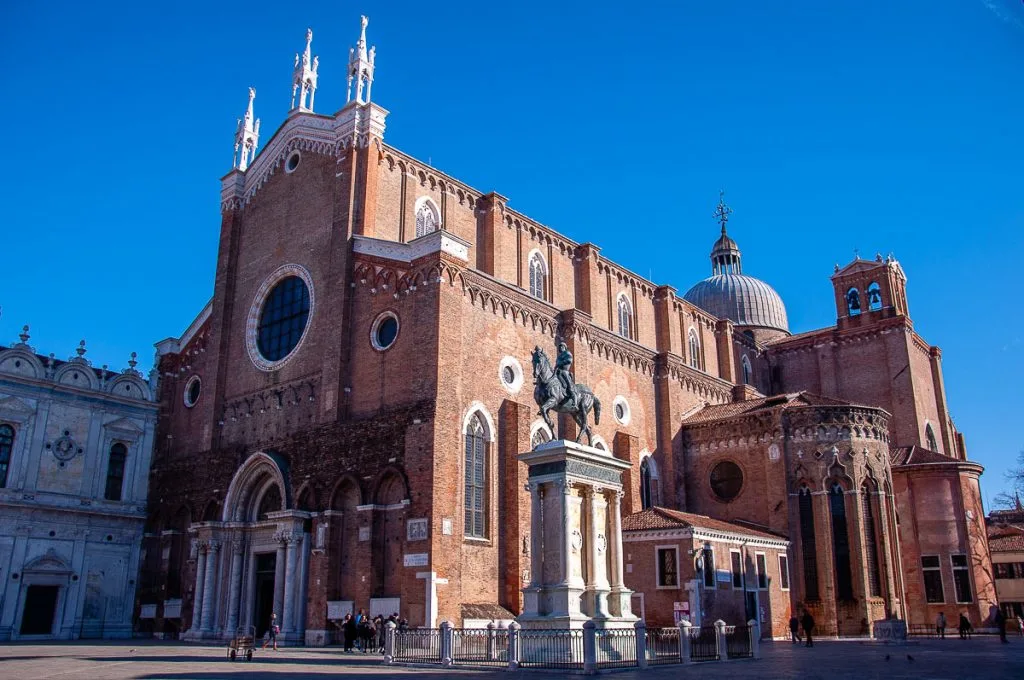
St. John and Paul Basilica (most widely known as Basilica of Santi Giovanni and Paolo) is an enormous Dominican church in Venice. Built of bricks in the Gothic architectural style, it stands in the sestiere of Castello. It houses the final resting places of 25 Venetian Doges and it has a stunning collection of art. 102 m long, the basilica is considered to be the largest in the city. Its dome dominates the Venetian skyline at a height of 55 m. Yet – while being one of the most important historic and religious landmarks here – the Basilica of Santi Giovanni and Paolo still manages to remain somewhat off the beaten path in Venice.
In 1234, Jacopo Tiepolo – the then-Doge of Venice – saw a beautiful place in a dream and heard prophetic words that he had to build a church at it. What nowadays is Campo dei Santi Giovanni e Paolo in Venice, at the time was a marshy land that was chosen for the spiritual enterprise. The first church was completed in the 13th century. As several Venetian doges were buried here, soon a need was felt to enlarge the church. This was accomplished in the 14th century and the basilica was consecrated on 14th November 1430.
Make sure that you visit the Basilica of Santi Giovanni and Paolo to see the monumental tombs of many important Venetian doges and Venetians of renown. Among them are the two famous painters Giovanni and Gentile Bellini whose masterpieces you can admire in Gallerie dell’Accademia and other must-see places in Venice.
Interestingly, the basilica has the largest Gothic polychrome stained-glass window in Venice. It was designed by the artists Bartolomeo Vivarini and Cima da Conegliano. It was made at the start of the 16th century by a master glassmaker from the island of Murano. The basilica also has many relics of Catholic saints. Among them is the foot of St. Catherine of Siena.
Curious Fact: Right in front of the Basilica of Santi Giovanni and Paolo stands a large statue of a military commander on a horse. It represents the Condottiero Bartolomeo Colleoni – a captain from Bergamo. He served faithfully the Republic of Venice and bequeathed a large sum to it with the stipulation that a monument should be erected to him. The statue was designed by Andrea del Verrocchio – most famous as the teacher of Leonardo da Vinci. After Verrocchio’s death, the monument was cast by Alessandro Leopardi – a sculptor and architect from Venice. It’s interesting to note that this is only the second full-size equestrian monument cast since the Antiquity (the first one is by the renowned Florentine sculptor Donatello and you can see it in the nearby city of Padua).
Practical Tip: Right next to the Basilica of Santi Giovanni and Paolo, you can visit another beautiful Venetian landmark – the Scuola Grande di San Marco. Housed in what nowadays is the building of the city’s hospital, it is a true gem for its architectural beauty, splendid paintings, and priceless collection of centuries-old medical books and tools. Opposite the basilica and the Scuola Grande, you can spend sweet moments of relaxation in Rosa Salva. This is one of Venice’s most visited historic patisseries. Its coffee, light bites, and traditional Venetian desserts are delicious.
Tickets and Tours: There is a small entrance fee to access the Basilica of Santi Giovanni and Paolo as a visitor. This is currently set at three euros. You can check up-to-date opening times and other pertinent information on the official website.
19. La Fenice Opera House (Teatro La Fenice) in Venice, Italy
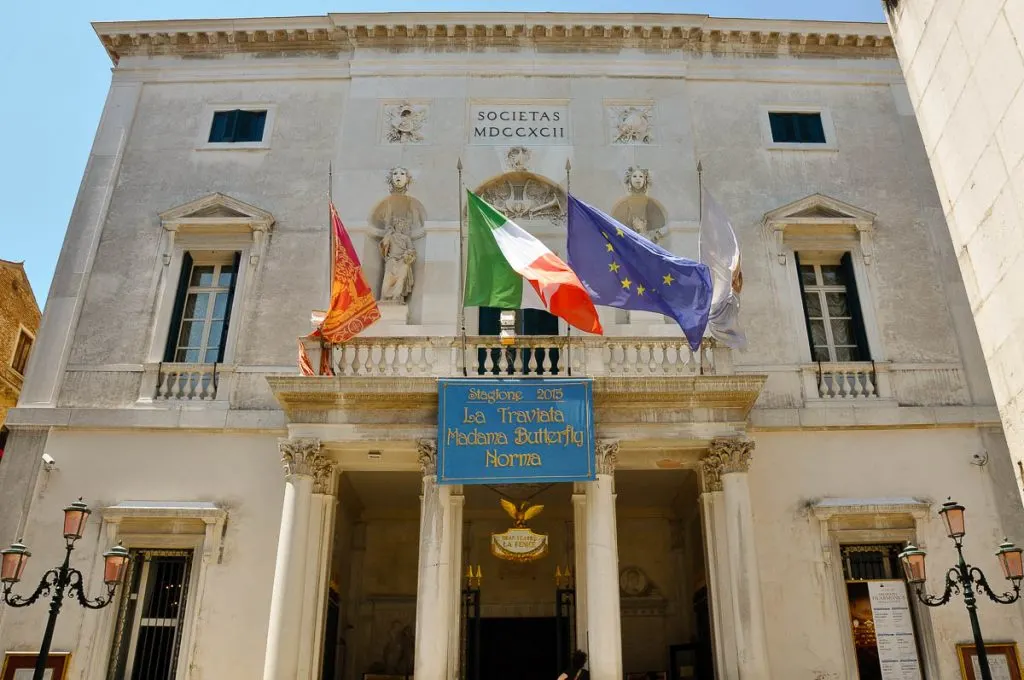
Teatro La Fenice is a lavish opera house in Venice. Its name means ‘phoenix’ in English and it is quite apt, really, as the theatre has twice been destroyed by fire only to be rebuilt back to its former glory.
La Fenice stands on a small sunlit square in the heart of the Venetian sestiere of San Marco. Its cream facade – symmetrical and rather plain – doesn’t betray the luxury inside. Step into the opulent opera hall and you will see that rich gilt ornamentation covers every available surface. Bunches of lights flicker around you. Rows upon rows of boxes follow the gentle curve of the walls. The ceiling is celestial blue and it is adorned with lace-like decorations. Right in the middle of it hangs a whimsical chandelier. You may plan to come here to see a performance, but it’s the opera hall that steals the show.
La Fenice was built between 1790 and 1792. It was the brand new house of a theatre company that had lost its previous building in a fire. It had its first performance on 16th May 1792. For its splendour and acoustics, it quickly became one of the most renowned opera houses in Europe. Many famous composers – among them Rossini and Verdi – debuted their musical masterpieces on the stage of La Fenice. In 1836, however, the opera house burnt down. It was rebuilt immediately and on Boxing Day 1837, once again music was performed in it.
The opera house burnt again on 29th January 1996. An arson attack was behind the tragedy. With the stage, the ceiling, and the rows of boxes destroyed, La Fenice was then rebuilt between 2001 and 2003.
Nowadays, this renowned building is a must-see in Venice. You can either attend a performance or come during the day to visit the opera hall and several other spaces. Either way, it’s a great experience!
Curious Fact: If you have an interest in music and the performing arts, don’t miss a visit to Venice’s Teatro Malibran. It’s a short walk away from La Fenice and it first opened its doors in the distant 1678. It stands at the spot where the house of the famous explorer and writer Marco Polo had once been.
Practical Tip: If you book to attend a performance at La Fenice Opera House, keep in mind that there is a dress code in place. This is especially strict for the Opening Night of the Season and premiere nights. If you don’t want to arrive in Venice with too much luggage in hand and yet you want to see an opera or a concert at La Fenice, then consider booking an afternoon performance. This is when a smart casual dress code is applied. Check the full details on the official website.
Tickets and Tours: Click to buy tickets to explore the premises of the fascinating La Fenice Opera House in Venice.
20. Scala Contarini del Bovolo in Venice, Italy
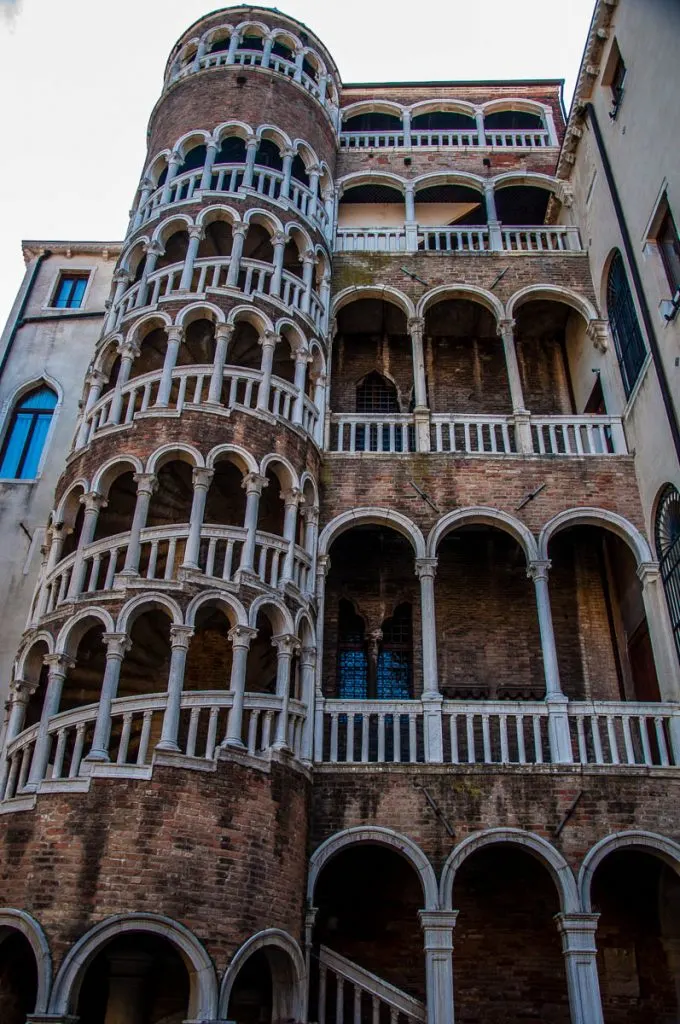
Scala Contarini del Bovolo is a spiral staircase that over the last few years has become one of the most photographed places in Venice. It is attached to a small palace – Palazzo Contarini del Bovolo. You will find it in a small courtyard in the Venetian sestiere of San Marco. It takes a bit of getting lost in the dense maze of narrow curving streets before and as if by magic, you come across the right place.
Bovolo means ‘snail’ in the Venetian language. It is a cute and quite apt description of the shape of the staircase. The only difference is that while the spiral loops of a snail’s shell get smaller and smaller to eventually close off, the loops of the Scala Contarini del Bovolo are perfectly symmetrical.
Made of red bricks and decorated with white Istrian stone, the staircase and the palace are very pretty. In the Venetian Renaissance style with remnants of the Venetian Gothic, they look as whimsical as if plucked out of a fairytale. You can climb to the top of the staircase to admire some of the best views of the rooftops of Venice. All in all, it can be very romantic!
Just be aware that there are 80 steps (six floors) to navigate to the top. The experience is worth it!
Curious Fact: The German astronomer Wilhelm Tempel took lodgings in Palazzo Contarini del Bovolo in the 19th century. He discovered a comet and a nebula from the terrace on top of the palace’s tower.
Practical Tip: You can arrange to have your wedding proposal in the dreamy surroundings of Scala Contarini del Bovolo. Alternatively, you can enjoy a mandolin concert here and even an animated visit with theatrical interpretations. It’s all organised by Gioelli Nascosti di Venezia. It’s an organisation that looks after this famous Venetian staircase as well as after four other little-known gems in Venice (of which, I particularly recommend the Oratorio dei Crociferi).
Tickets and Tours: Click to buy your tickets for Scala Contarini del Bovolo in Venice.
Map of the 20 Venice Landmarks You Simply Have to See
In Conclusion
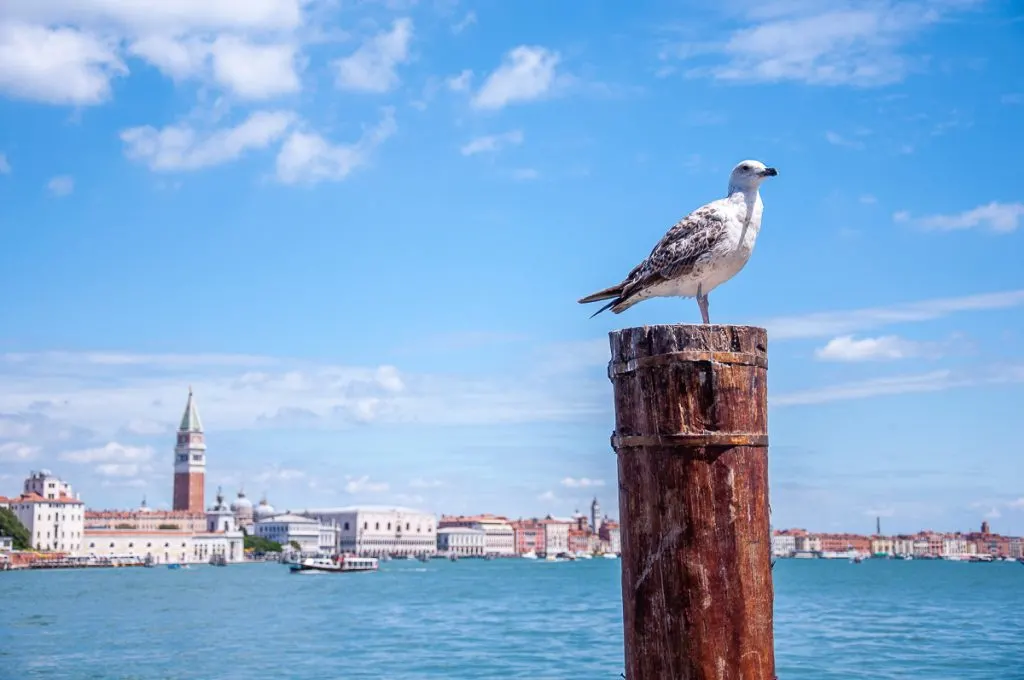
Venice in Italy is one of the most famous places in the world and a destination that simply has to be seen. Universally known as the city of water, Venice is built on a cluster of islands in the heart of the Venetian Lagoon and has a history that spans 1,600 years.
Rich in things to do and must-see sights, Venice offers many exciting experiences to the curious traveller. From monumental buildings to historic churches, from unique to Venice architectural styles to a huge accumulation of art, there is so much to see here, that planning a visit to the city of water can quickly become an overwhelming task.
This is why in this blog post I give you a nice and tidy list of 20 major Venice landmarks. With a short historic overview and a handful of practical tips and curious facts, the information about each one of them will help you plan what you want to see in Venice and how much time you want to spend at each sight. A handy map also shows you where each of these 20 Venice landmarks stands, so that you can group your visits to them depending on location and your personal interests.
It’s all based on my own visits to Venice over a period of 15 years (six of which I actually spent living next door to the city of water). I love Venice and enjoy visiting and re-visiting its landmarks. I hope that with everything I have written in this blog post, I have managed to spark your curiosity and desire to discover Venice in the best possible way and to see the landmarks that make it one of the greatest cities in the world.
Have a wonderful time exploring Venice!
And let me know how many of these 20 Venice landmarks you managed to tick off and which one was your personal favourite!
More Helpful Venice Info for You
Venice: Essential Tips, Hidden Gems, Best Tours, Venetian Place Names, Venice in a Day for Art Lovers, Nearest Airports, Boats in Venice, Haunted Venice, Day Trips from Venice, Arco del Paradiso
Venice Videos: Grand Canal, St. Mark’s Square at Carnival, St. Mark’s Square, View from Rialto Bridge, View from Accademia Bridge, Venetian gondolas, Historical Regatta, Squero di San Trovaso, Palazzo Contarini del Bovolo, Fondazione Querini Stampalia, Palazzo Grimani, Rialto Fish Market, Ca’ Macana, Festa della Madonna della Salute
More Helpful Italy Info for You
Best of Italy: Italian Piazzas, Italian Food, Italian Markets, Italian Coffee Culture, Rules of Italian Breakfast, Italian Breakfast Foods and Drinks
Northern Italy: 18 Best Cities to Visit
Lake Garda: Best Towns, Nearest Airports, Travel Options, Lake Garda with Kids, Malcesine, Riva del Garda, Torri del Benaco
Lake Como: Things to See, Nesso
Veneto: Best Cities to Visit, Top 15 Places, 30 Adventures, 15 Most Colourful Places
Friuli Venezia Giulia: Venzone, Most Beautiful Villages
Emilia Romagna: Bologna, Ravenna, Comacchio, Most Beautiful Villages
Marche: 6 Reasons to Visit, Gradara, Frasassi Caves, Temple of Valadier
Verona: Things to Do in One Day, Day Trips from Verona
Padua: Things to Do in One Day, 101 Facts About Padua, 10 Reasons to Visit Padua, Day Trips from Padua
Vicenza: Things to Do, 10 Must-See Museums, Day Trips from Vicenza

